ARTIST AS ORGANIZER
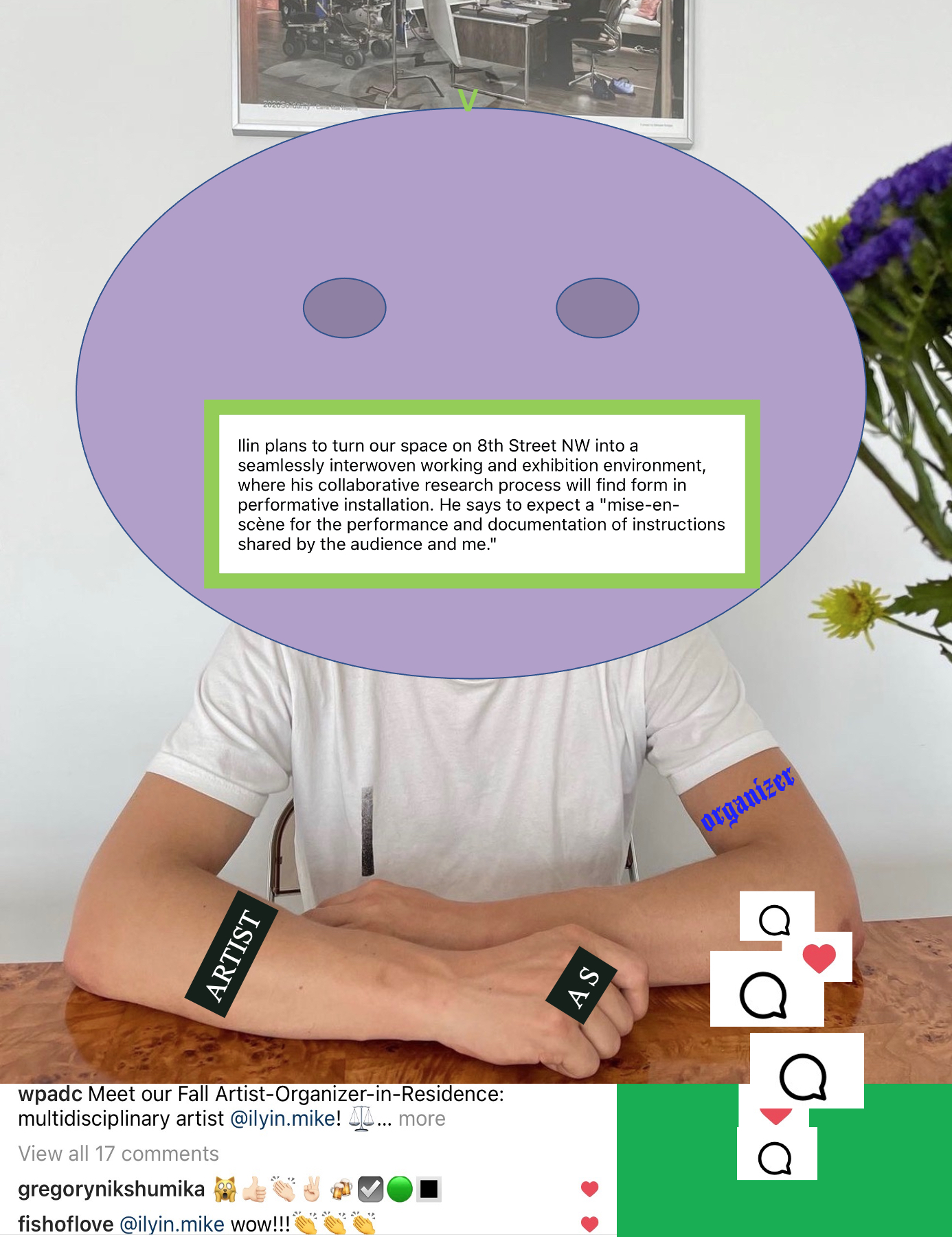
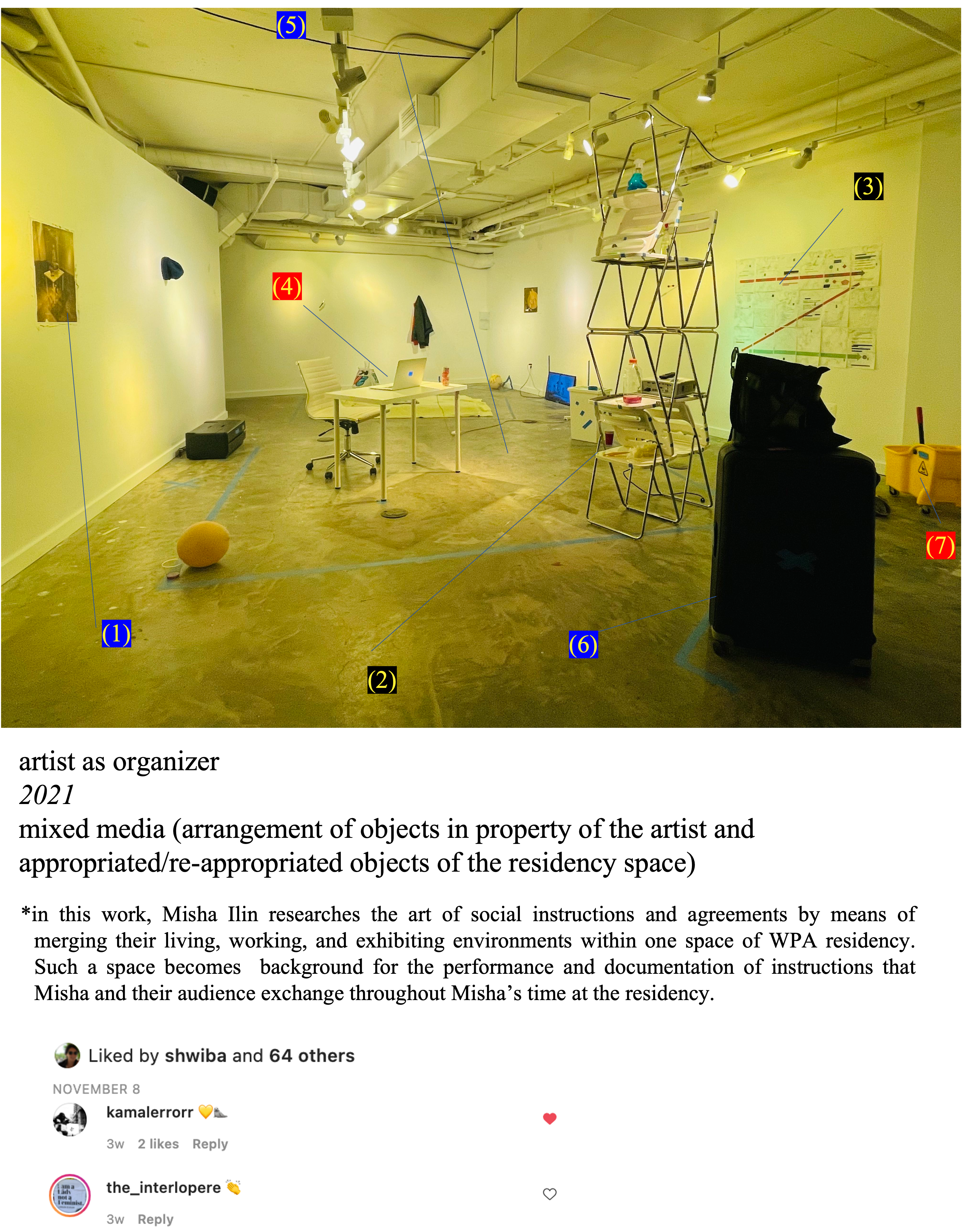
let’s start

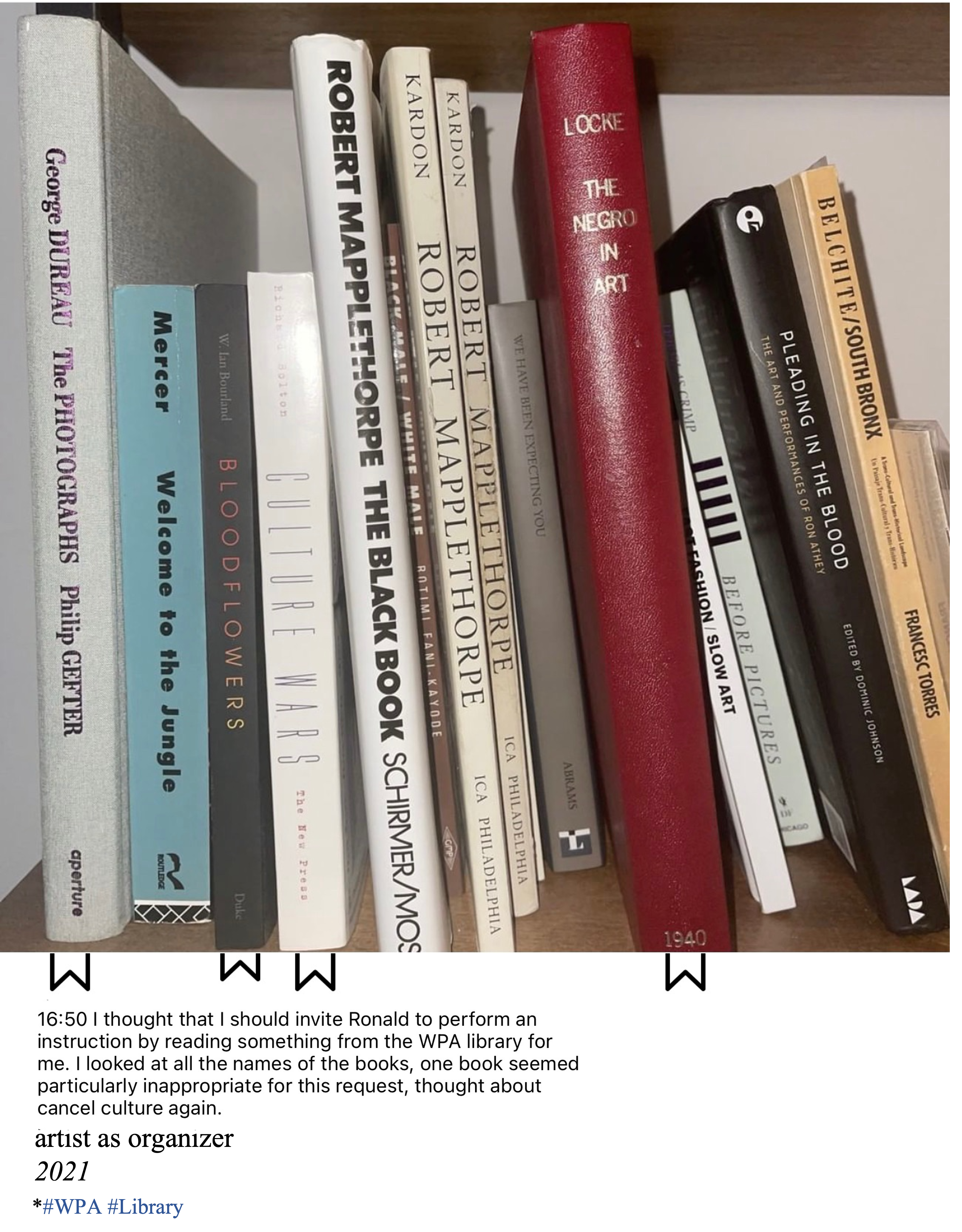
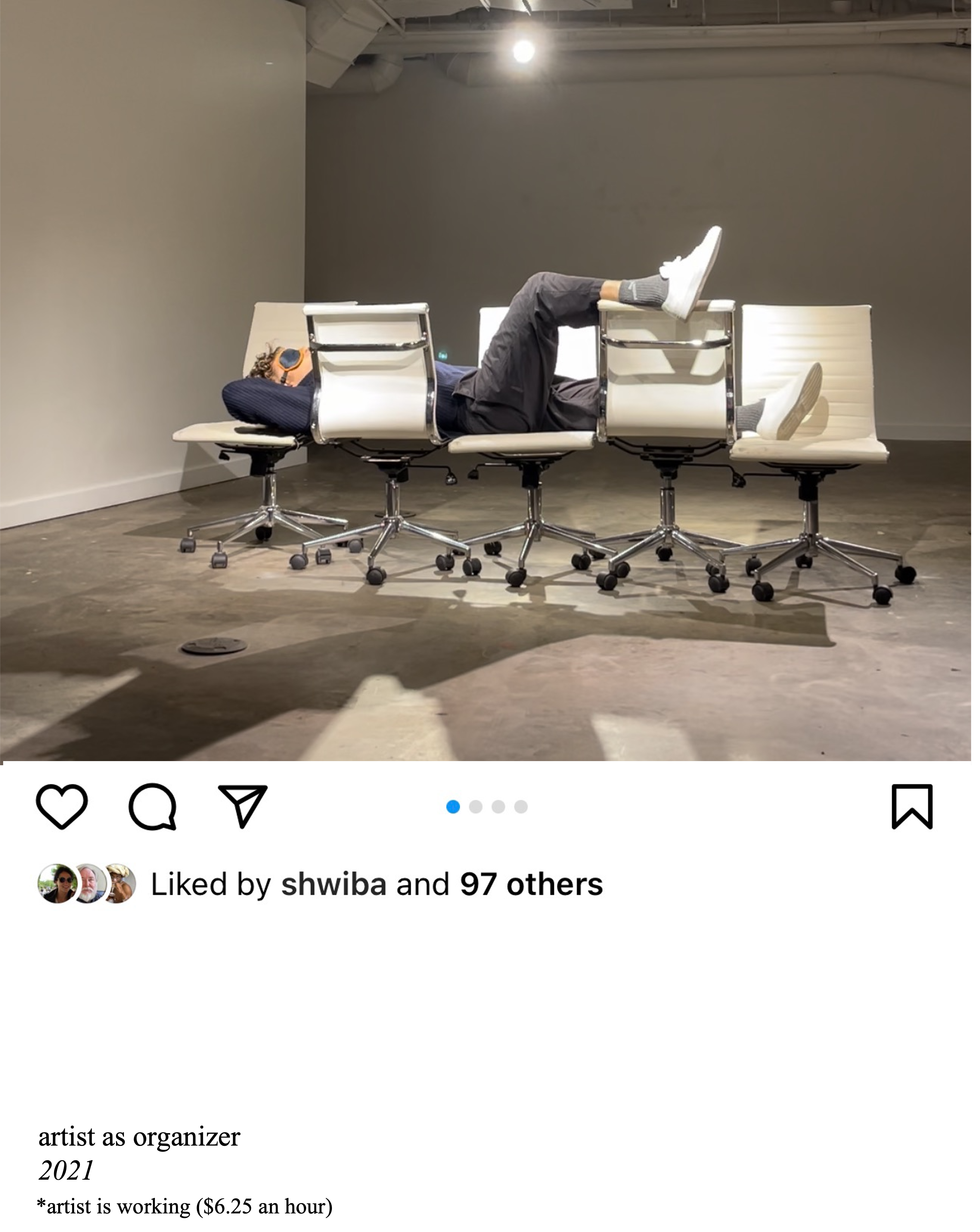
When I arrived at the space, it was empty. I also didn't have a definitive view on how the project would eventually look like (apart from the general idea which I have submitted to WPA), So, the first week I was just staying in the space and playing with domestic objects of WPA (like chairs that were already available in the space). That week I also started my Instagram residency log, which eventually became an important element of this project. Those residenc logs were a dry summary of what was happening in the space during that day, but from time to time they took the form of reflection or a small story in relation to the instruction that I was performing. Other elements that emerged also at the very beginning of this project were Instagram's lives. Often these lives didn't have any particular narrative functions but rather their function was in that of inscribing mundanity and life into the frame of the art practice.
but first a bit about the space.
!space


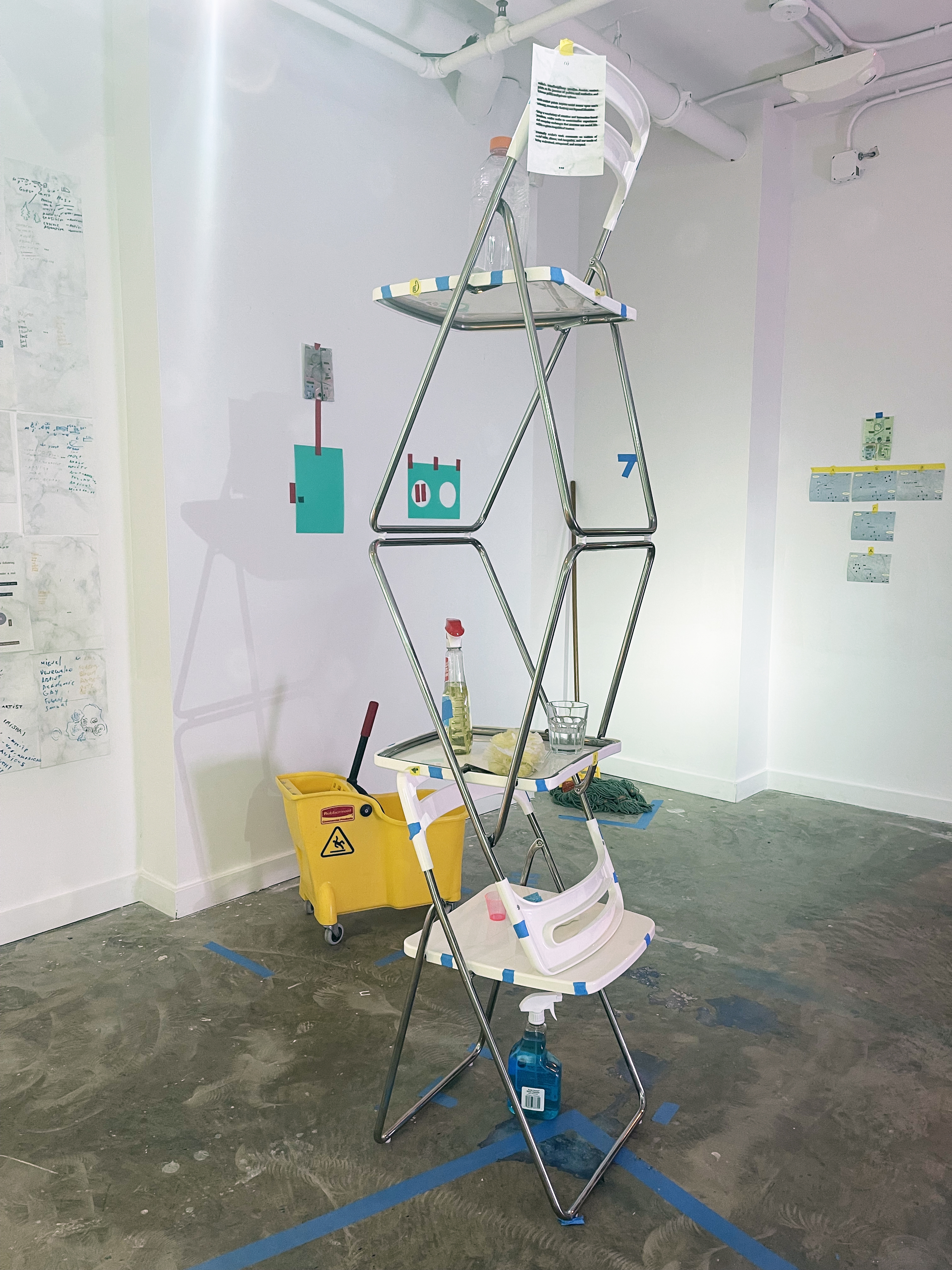
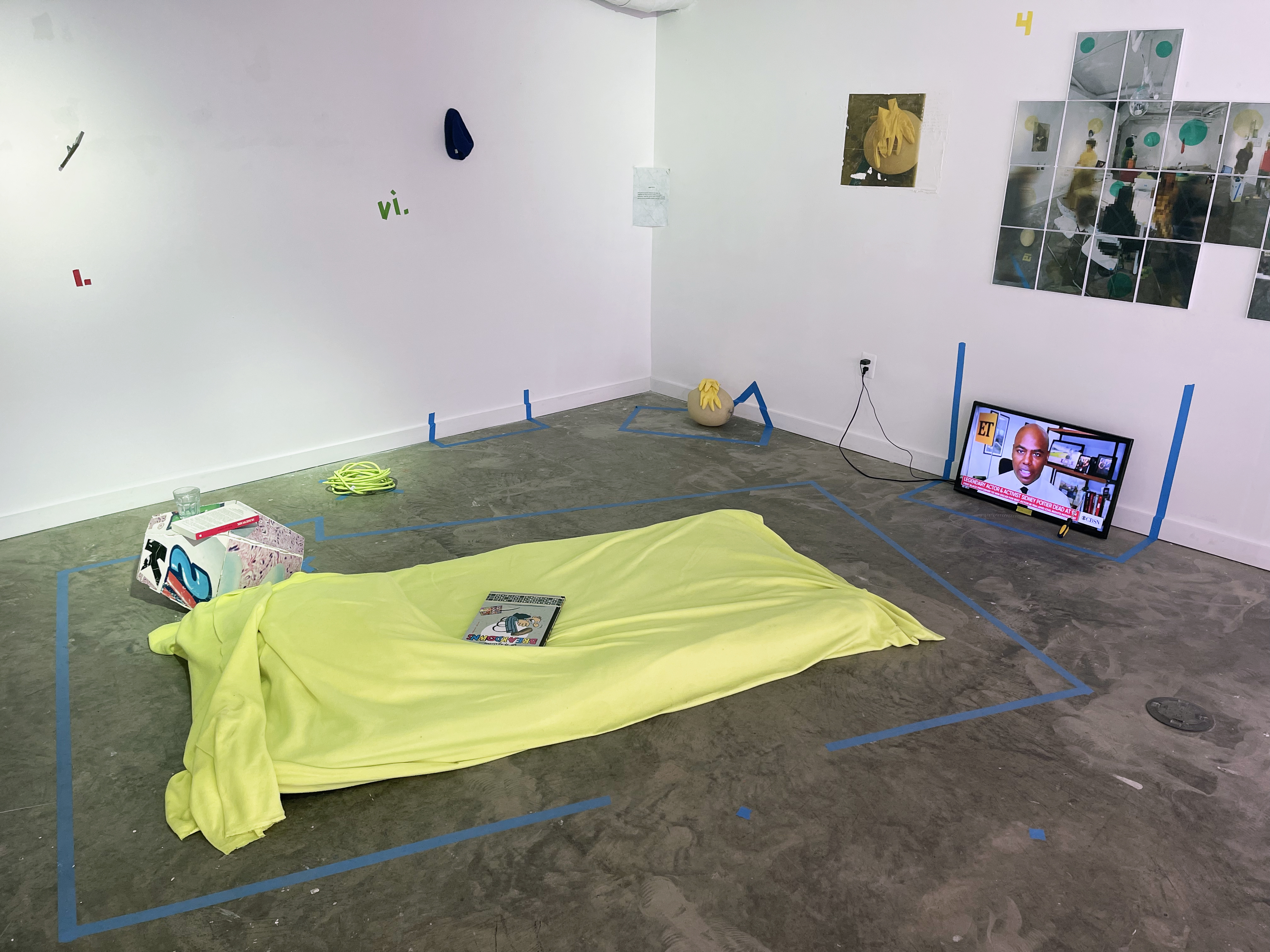
From the formal standpoint, my residency space took a shape of performative installation, comprised of appropriated and re-appropriated mundane objects that belong to WPA or of personal use, that I brought from home. Some of these objects took the form of domestic sculptures (like stacking of chairs) or (de)compositions of domestic items (like instruments, clothes, cleaning products) arranged on the floor and the walls of the space. To give a sense of decisiveness to these arrangements I used colored tape that eventually functioned to outline the space for these objects (as one curator said they were like people six feet apart from each other) and to delineate an environment for a view and movement of the body of the audience. Another element that shaped the phenomenology of the space is the colored lights (i used green and yellow light filters). decision on the colors was rather a symbolic one, as I use a yellow light in reference to eternal Sunday afternoon in opposition to officy coldness of the green one.
project structrure
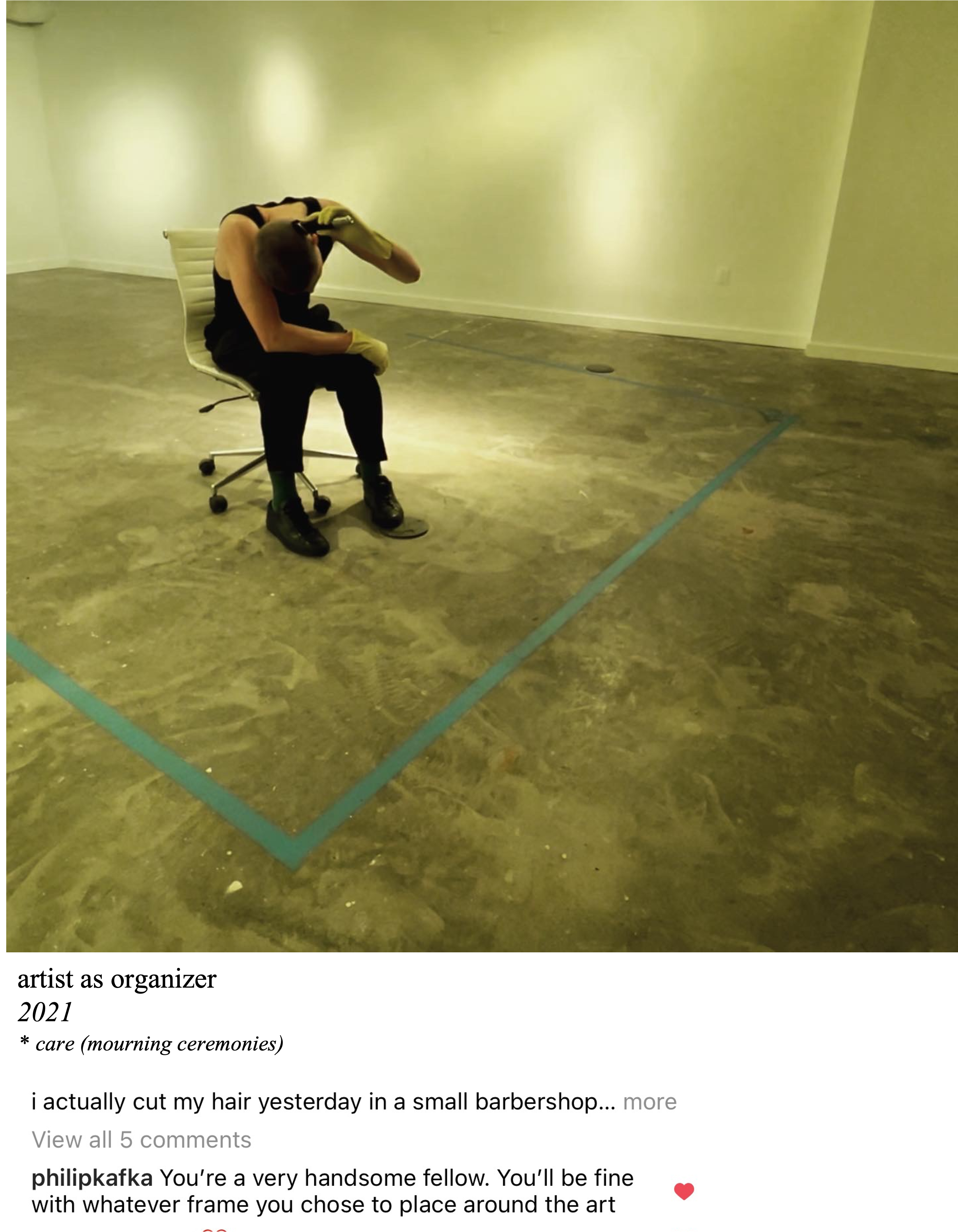
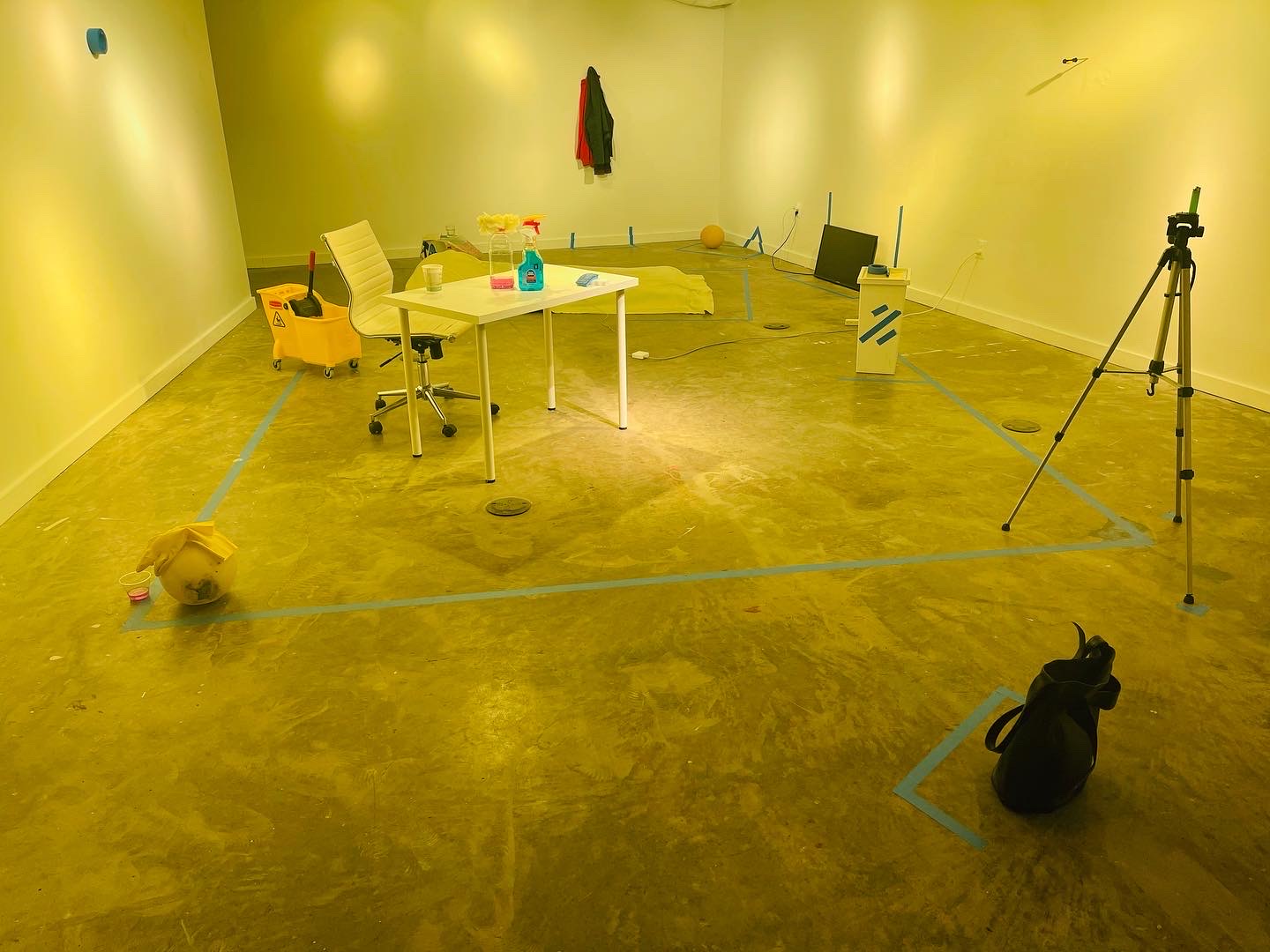

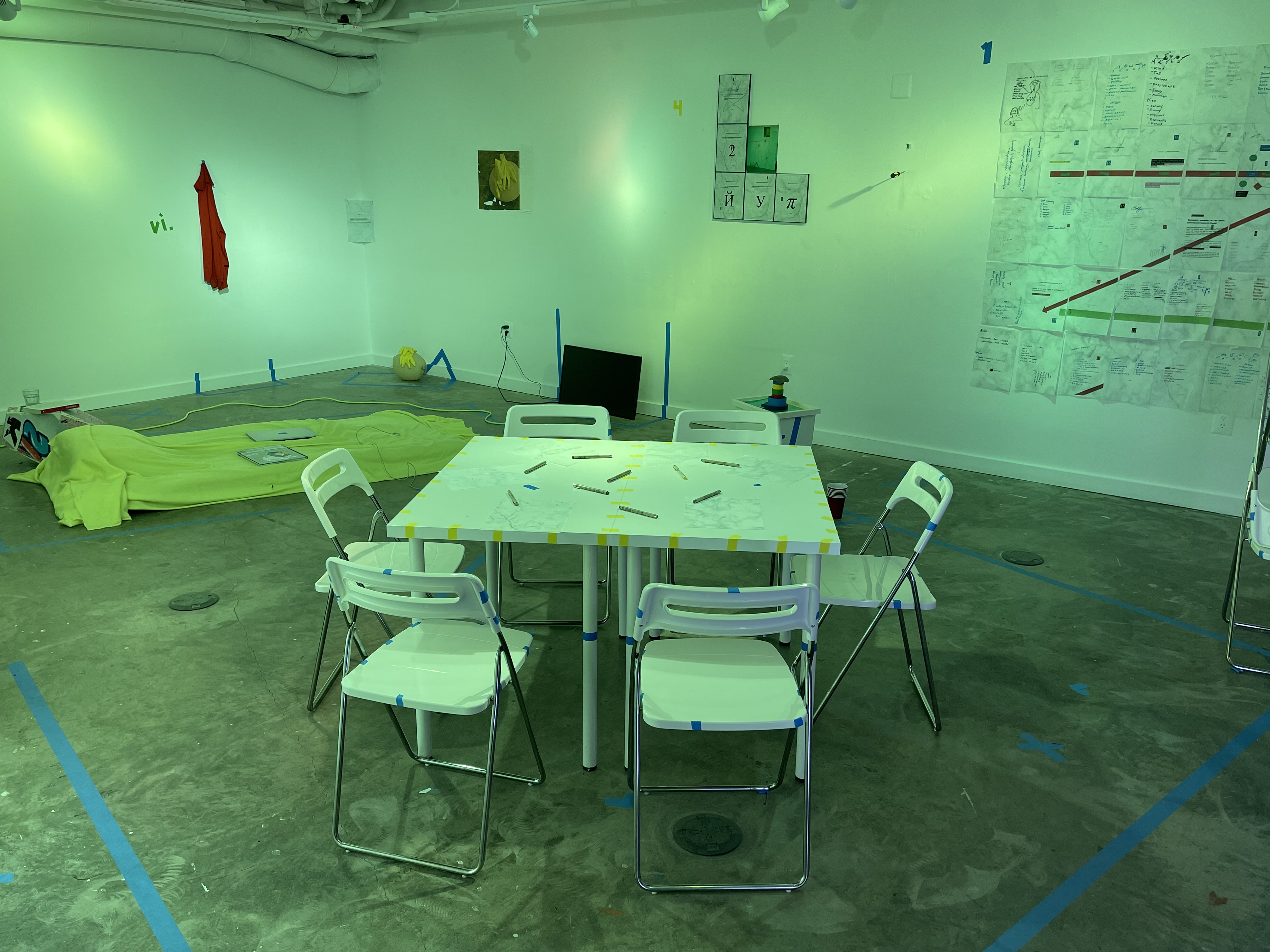

As the project finally took off (after my first week of rooting into the space) I decided to organize possible situations and instructions I shared with my audience within the three following themes: care (care of the space and creatin domestic environment), domesticity (living in the space, actually sleeping in the space), and institutional week. The latter was related to the moment when my residency space and administrative area of the WPA team were to merge due to the WPA team's decision to be present in their space during December.
*care weeks (first theme)*
![]()
![]()
![]()
![]()
![]()
During the first theme (care) I was literary taking care of the WPA space on the 8th street NW by performing the set of instructions under the same name. Originally I ‘developed’ this set of care instructions when I left my studio in Baltimore (that spring also I lost my father) and decided to stay all summer at home with my partner. While my partner was working I was taking care of our domestic environment. Once, when I was cleaning a fridge, I realized that arrangement of food I made on the table, while I was cleaning, looked like some modern version of vanitas paintings (a genre of a still life of food/objects composition depicting the transience of life that emerged in the 16th century). To preserve this arrangement which both shared qualities of sculpture and painting, I wrote my first instructions. I got also interested that this instruction was also rendering a set of my identities (what country I wa residing, nationality, marital status, food habits, etc.), interested in such a quality of these instructions I started to share them with other people.
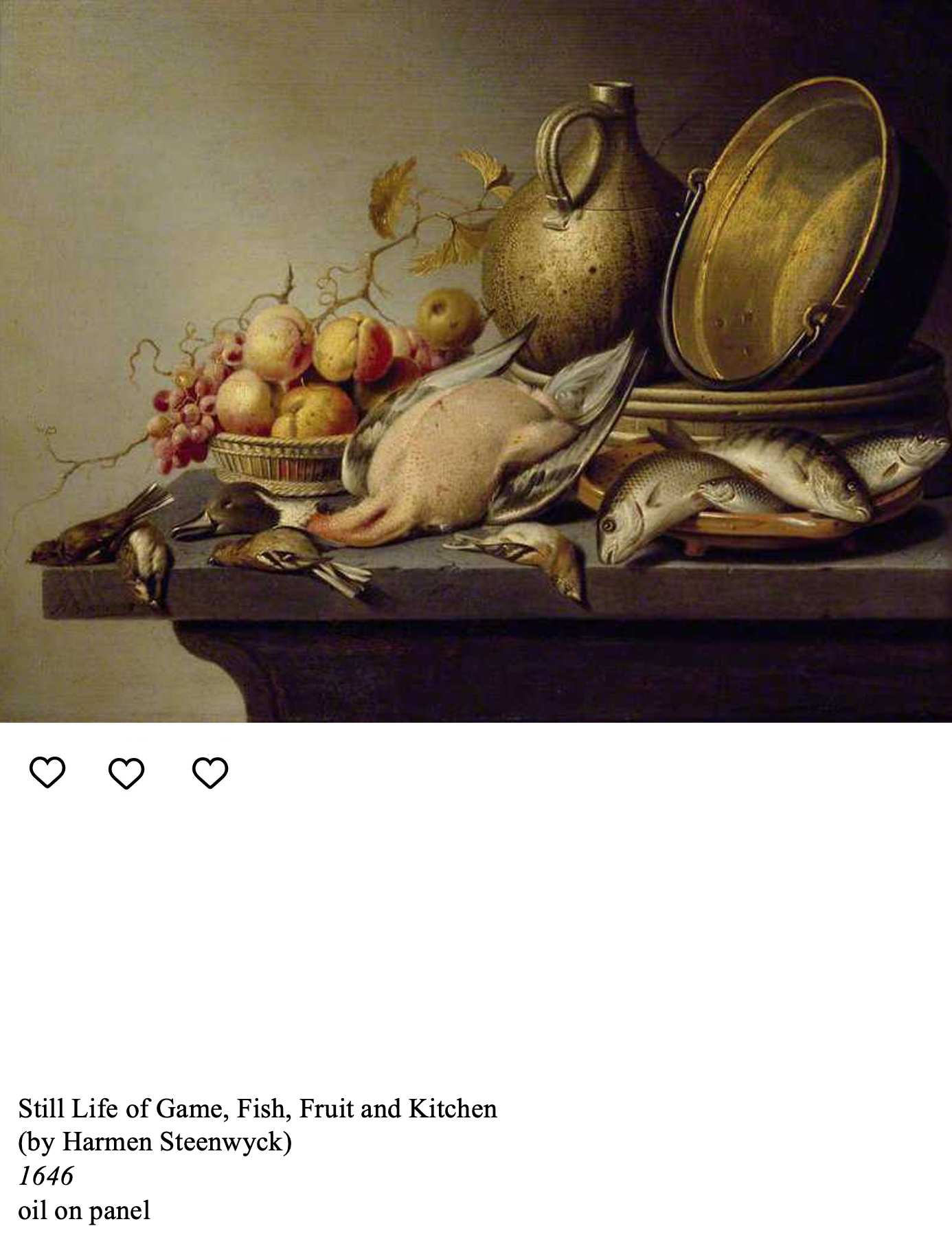
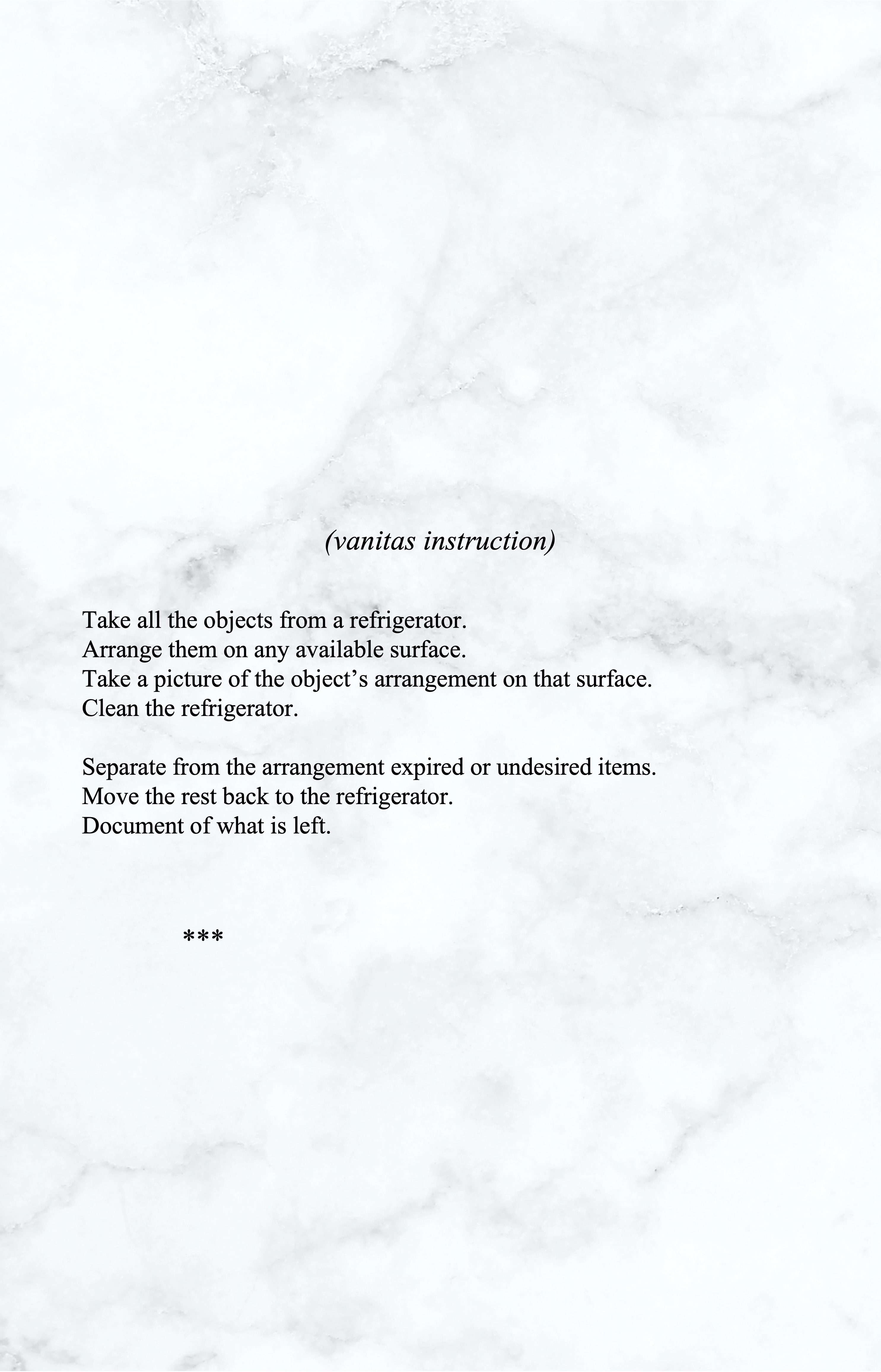

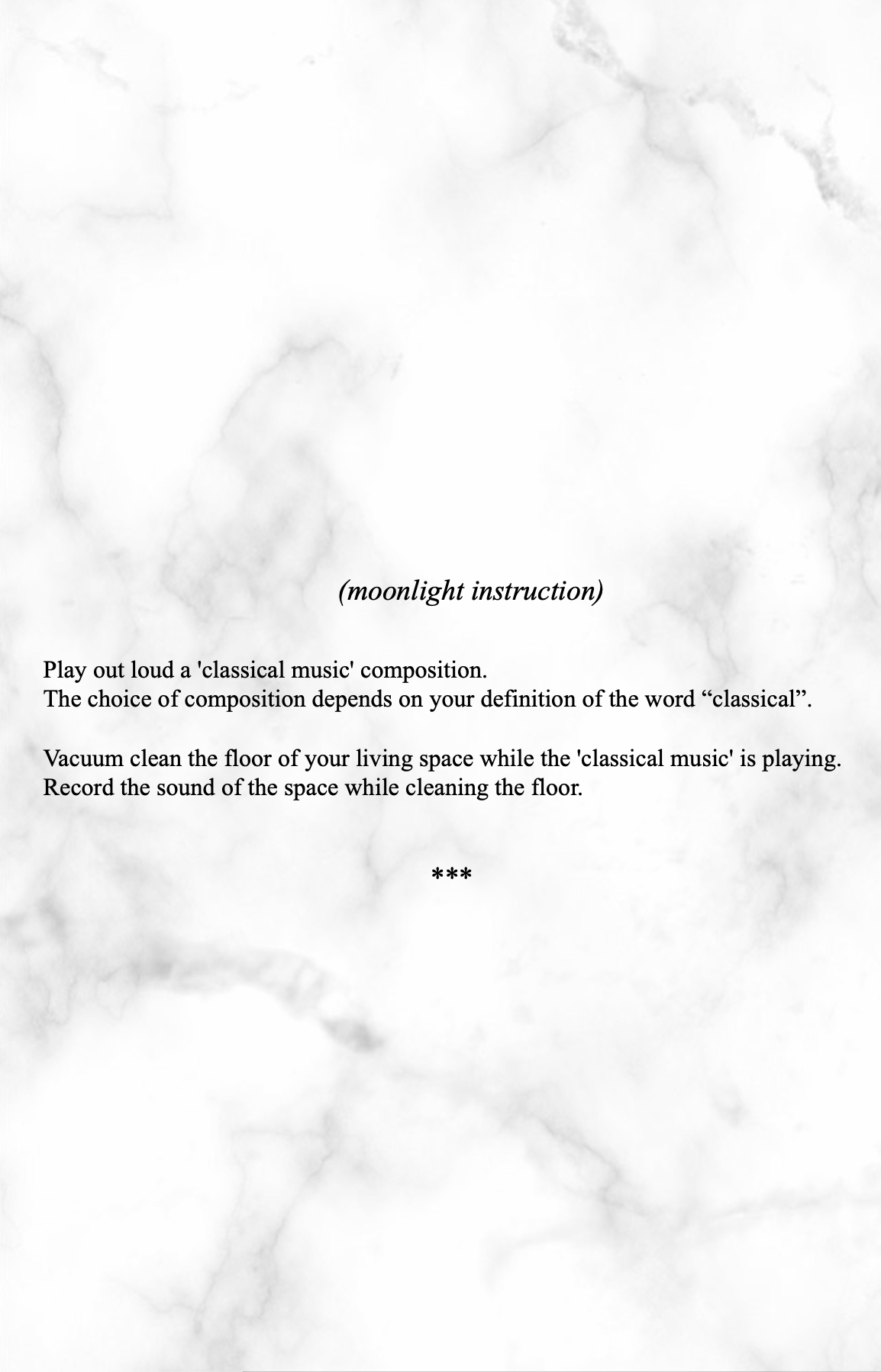
Eventually made another 5-6 instructions of the same type. For instance the instruction above brings one very vivid memory. i am coming from school and at the door, i hear someone is cleaning the house. The sound of the vacuum cleaner is mixed with that of the piano. my sister is studying for her piano lesson. this was my first 8 years old experience of ultimate existential boredom.
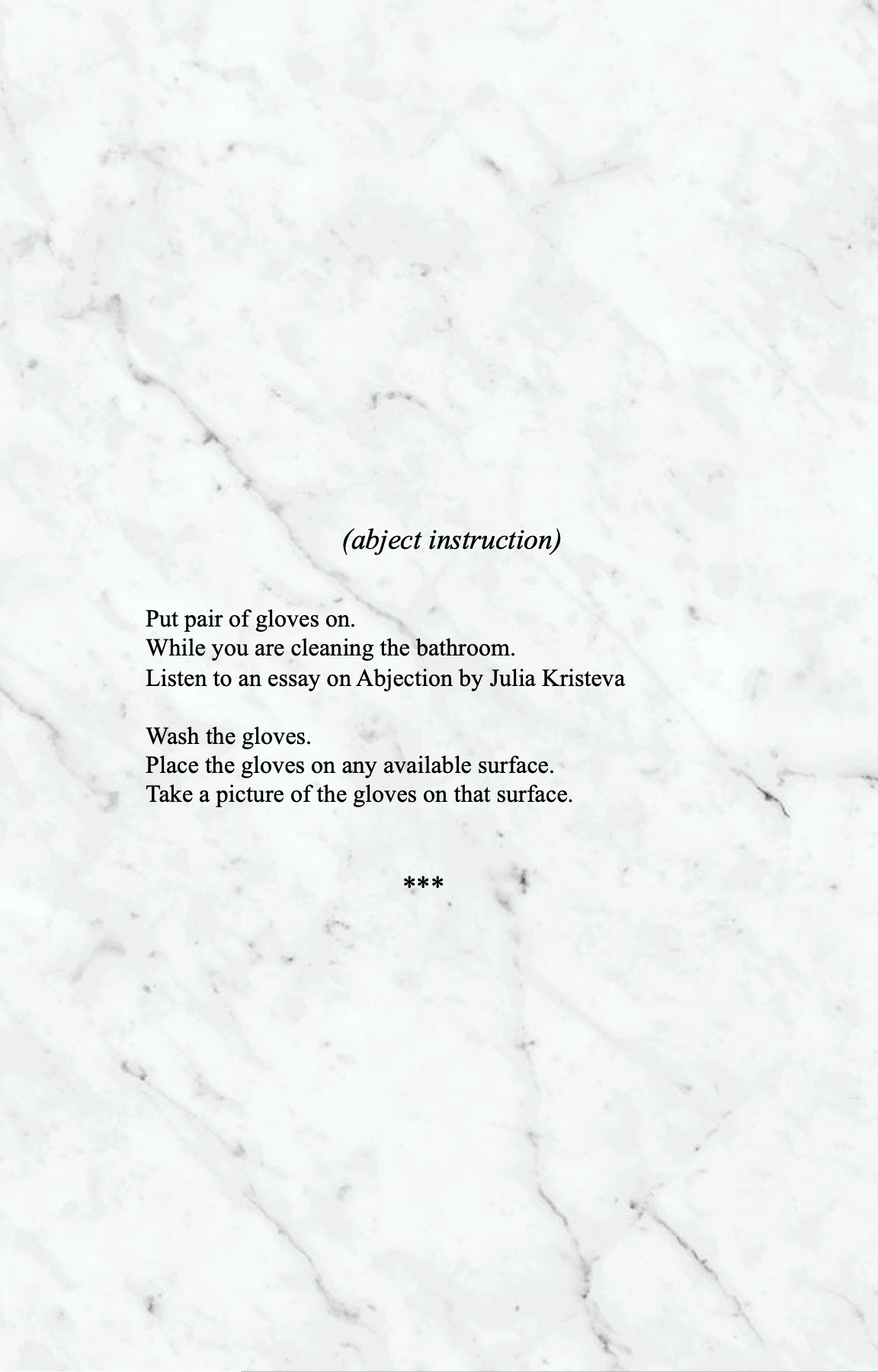

Apart from instruction’s conceptual side or capturing a particular feeling, there was certainly a gender performative aspect to this type of instructions (specifically play of social roles, which would be seen as inverted for my couple in the country where I am from). In this respect I would mention the abject instruction (see above), which was about me cleaning the bathroom while listening to the google reading of Julia Kristeva essay on abjection. However apart from these two layers of the care instructions that was obvious to me, I discovered – later – a third one, which wa related to the death of my father. I realized that doing these caring instructions were not only a gender performance but also a practice o synchronization with the grief of my mother who was performing these daily gestures around her husband, who, being trapped in previous generation gender norms, and never took a broom in his hands – and a form of compassion to her in this new reality where my father was absent. Hence for me, these instruitons were also a mourning ritual or a ceremony that outline a symbolically absent space, once occupied by my father, and mourning process I didn’t have time to do properly at that time (because of various circumstances), but finally was able to conclude in the space of the residency.

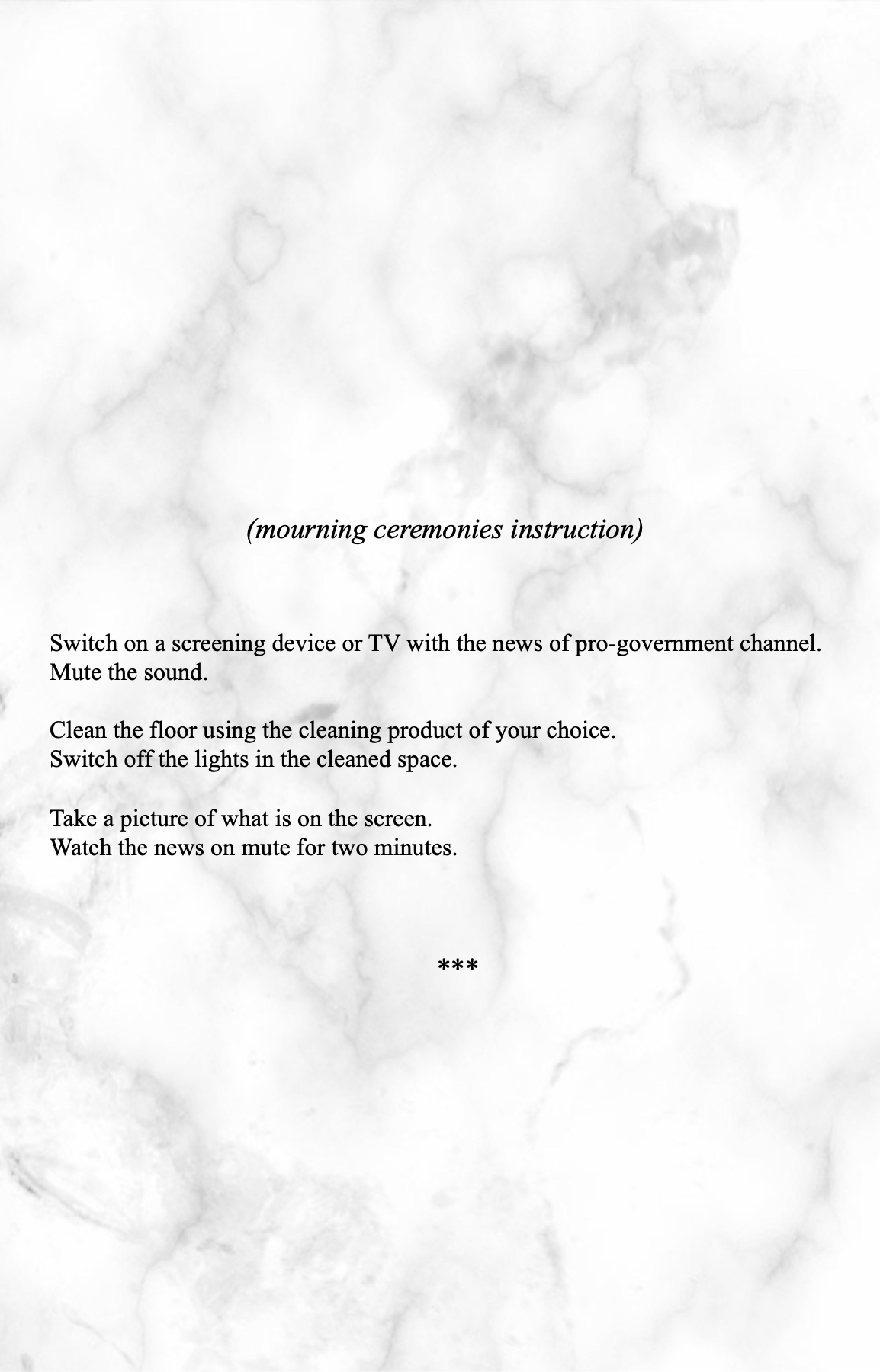

detournement *i
 During this first part of my time in the residency, I also gave lectures about this project at VCU and America University. The group of students from the latter also came to visit me in the space. It was a class, that worked around ideas of identity construction. Eventually, this visit grew into a separate line of work, which started with requesting the class and later other visitors of the space (again in the form of instructions) to share with me (write down on a sheet of paper) their sets of identities.
During this first part of my time in the residency, I also gave lectures about this project at VCU and America University. The group of students from the latter also came to visit me in the space. It was a class, that worked around ideas of identity construction. Eventually, this visit grew into a separate line of work, which started with requesting the class and later other visitors of the space (again in the form of instructions) to share with me (write down on a sheet of paper) their sets of identities.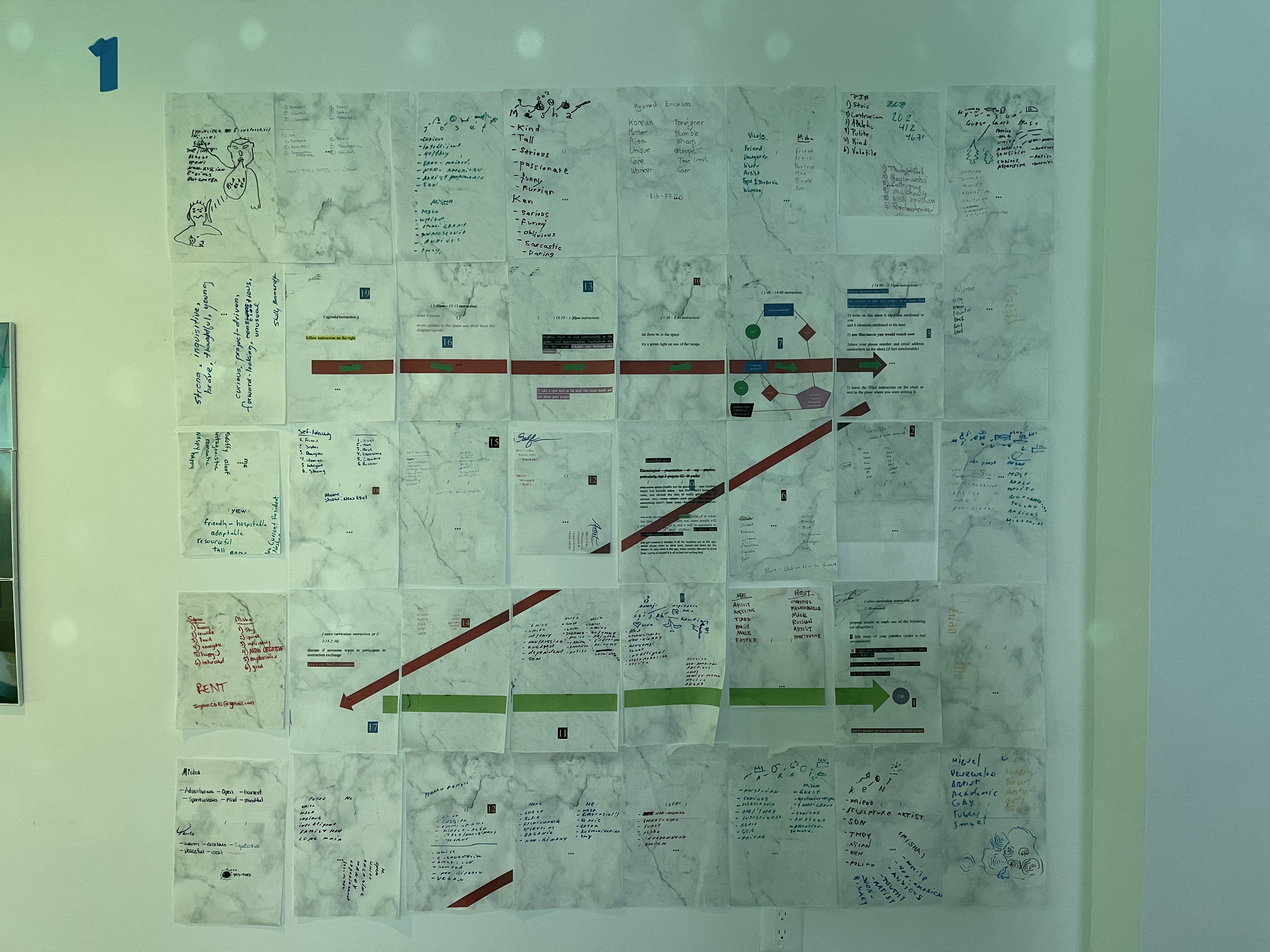

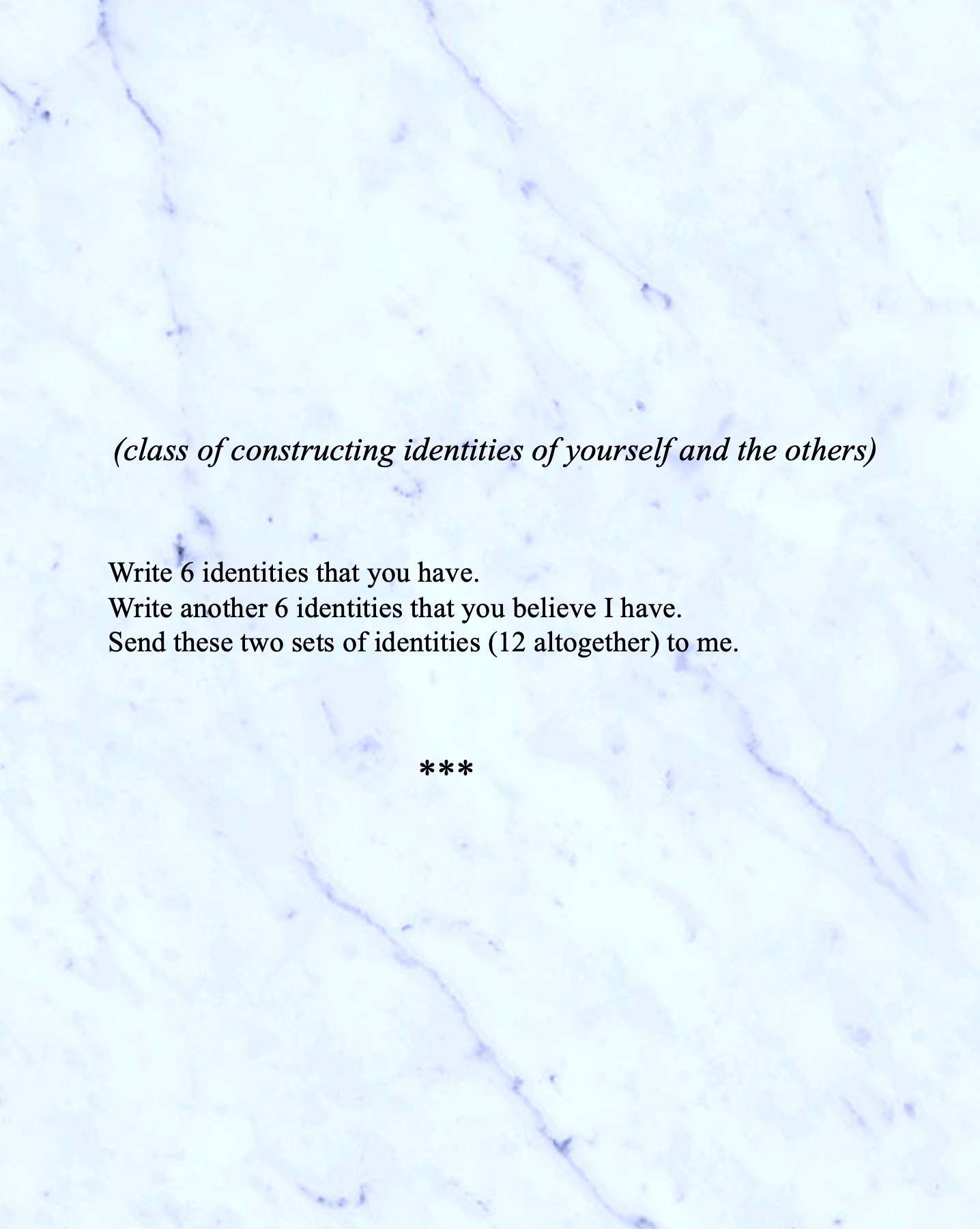

Sometime after this meeting, I read an article, about qualities that should have the perfect policemen according to the population of Russia (without irony). Interestingly the author of the article decided to share this set of identities of a perfect policeman (basically a list of eight qualities that were mentioned by responders) with a neural network. In response, the neural network by using provided textual information created perfect ‘Russian‘ policeman’s visual portrait. I found this idea intriguing and decided to make something similar, but with sets of identities that were shared with me by the visitors of the residency. Eventually with help of an A.I. I created a series of portraits o real people based on the identities they shared with me by performing the aforementioned identity instruction (swipe images above to see one, if you have’t yet).
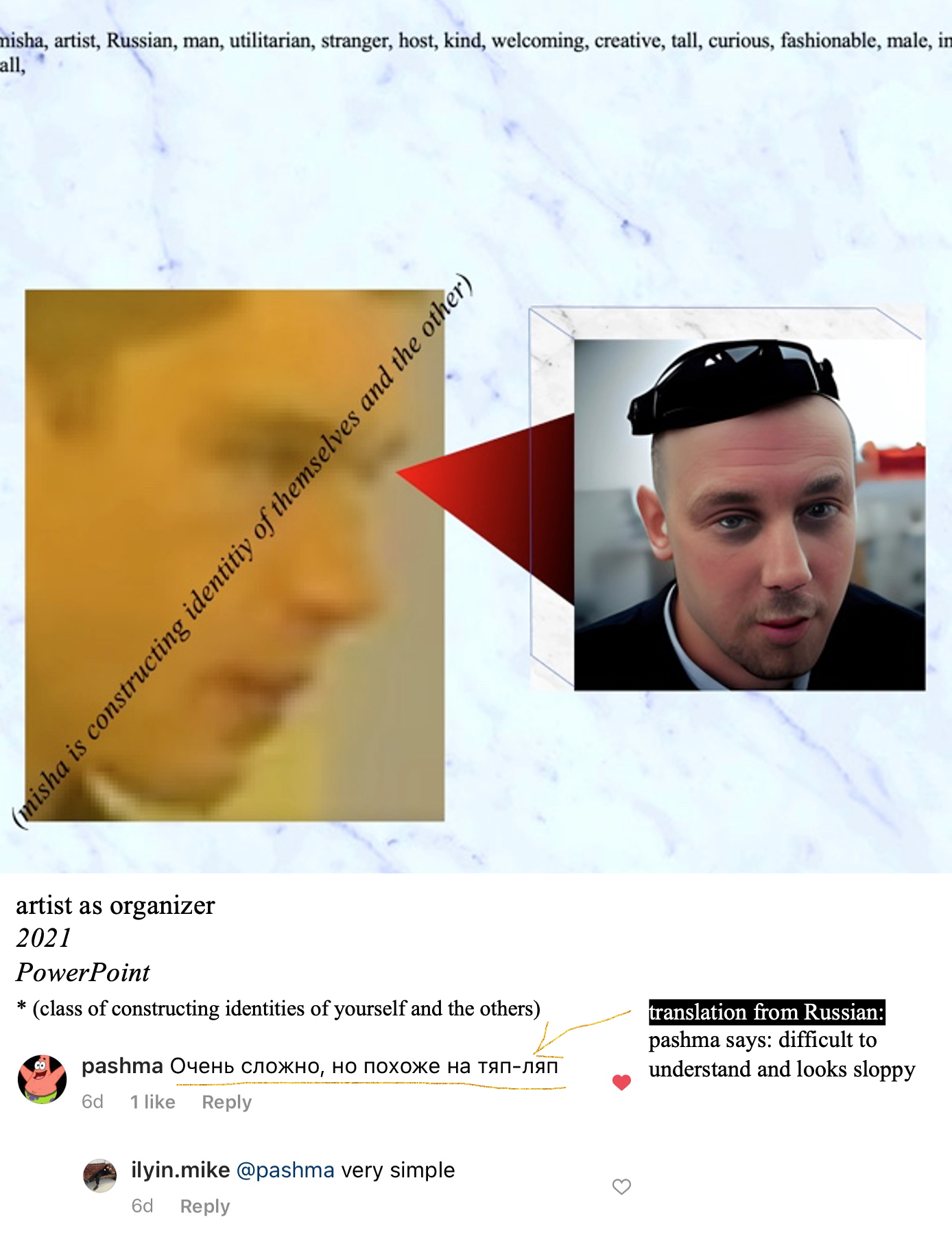
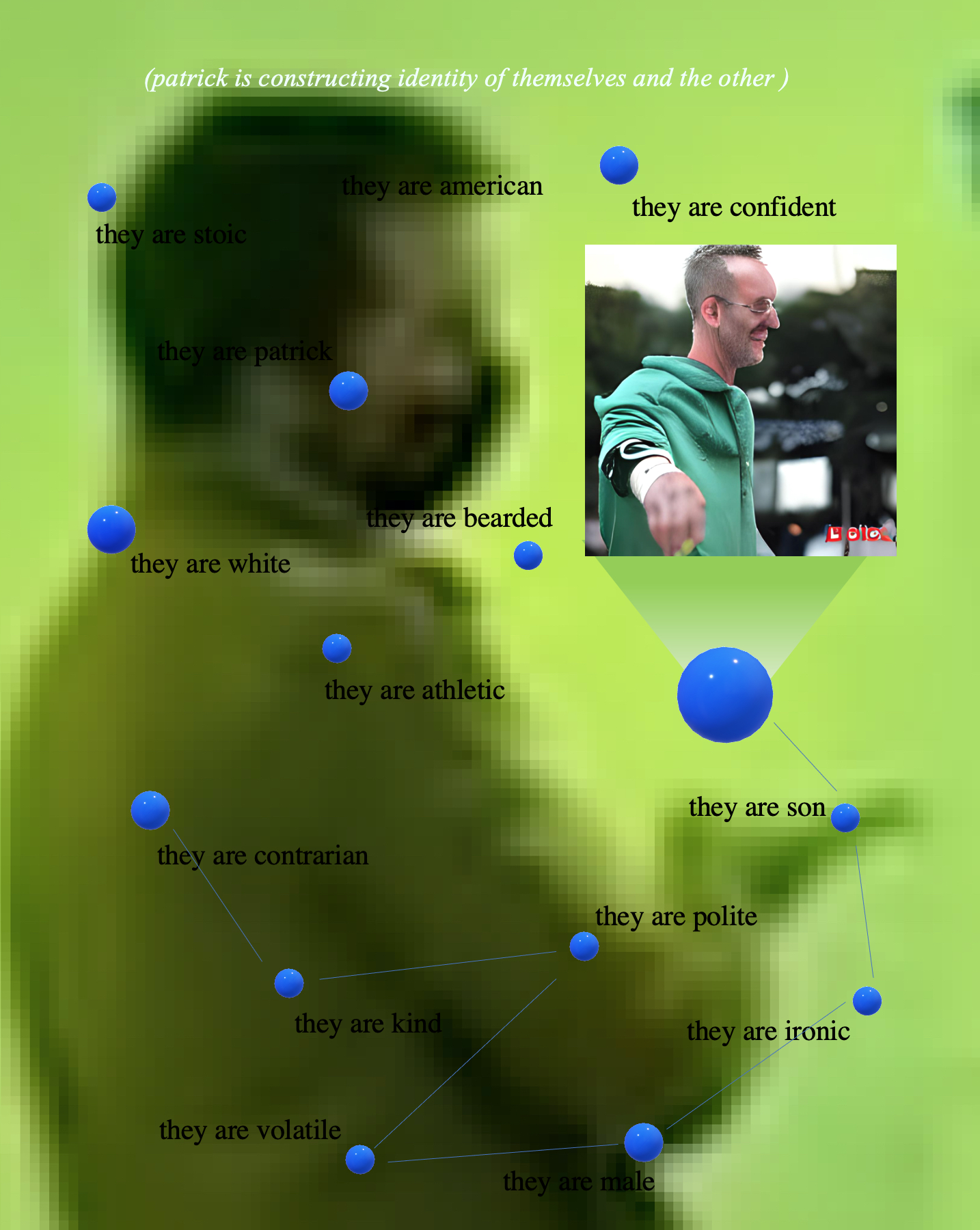



Analysis of mistakes that A.I. makes while working with textual information and images that it creates (see above pairs of real person image paired with that created by the neural network) can be another theme of research given that these mistakes and images generated can be quite telling about the environment from which A.I. learns.
~class of creating identitites of yourself and others
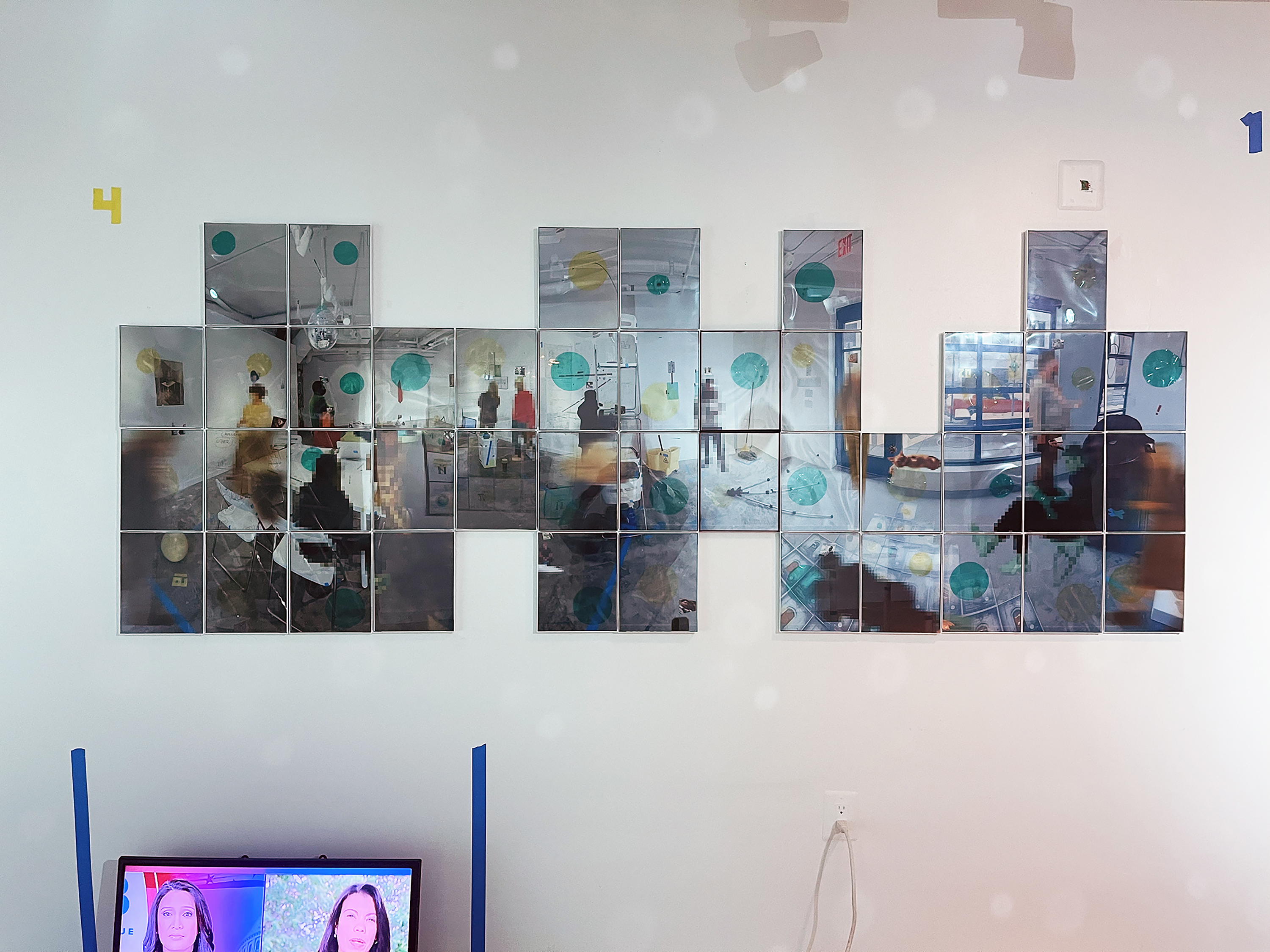

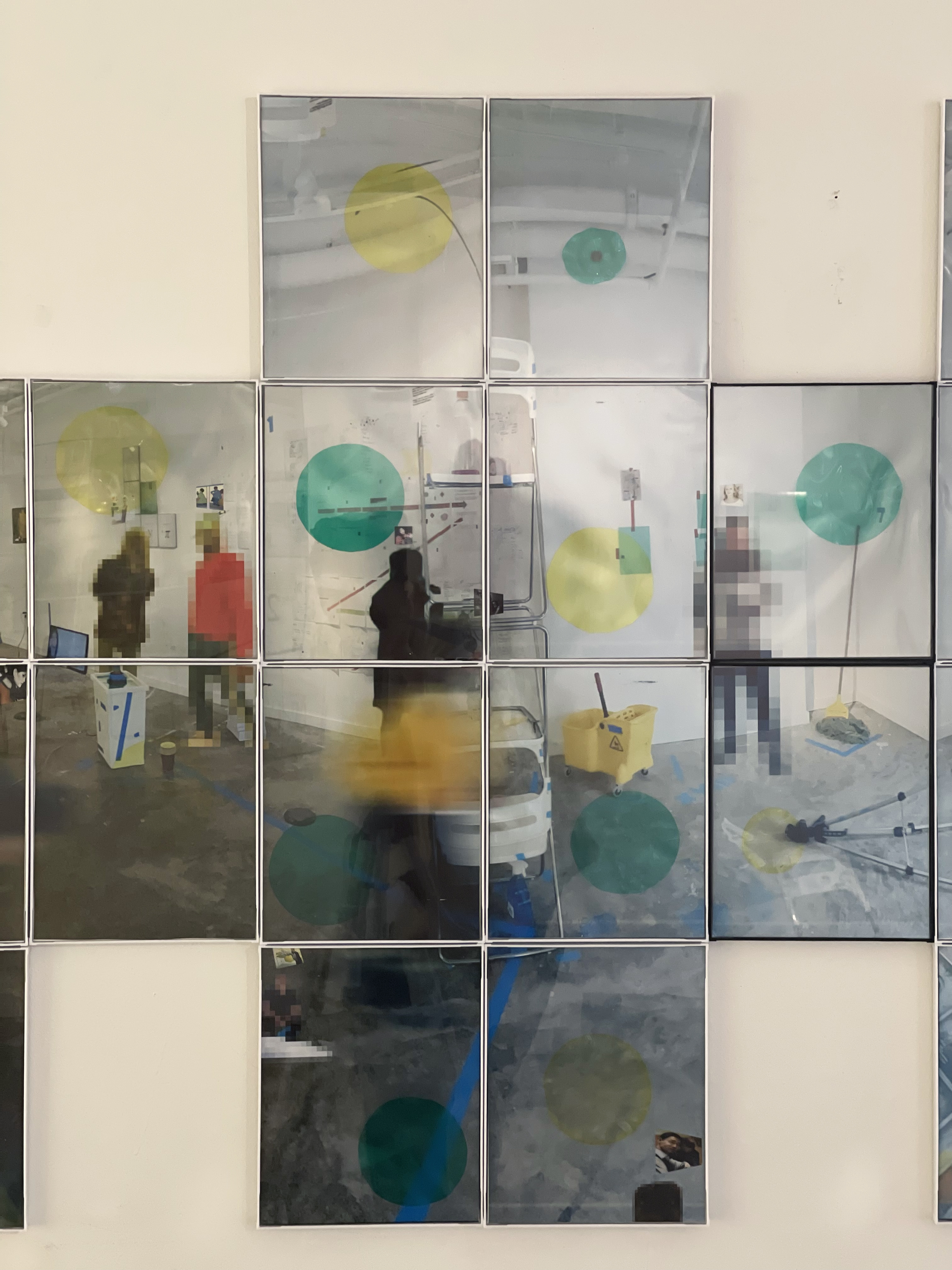
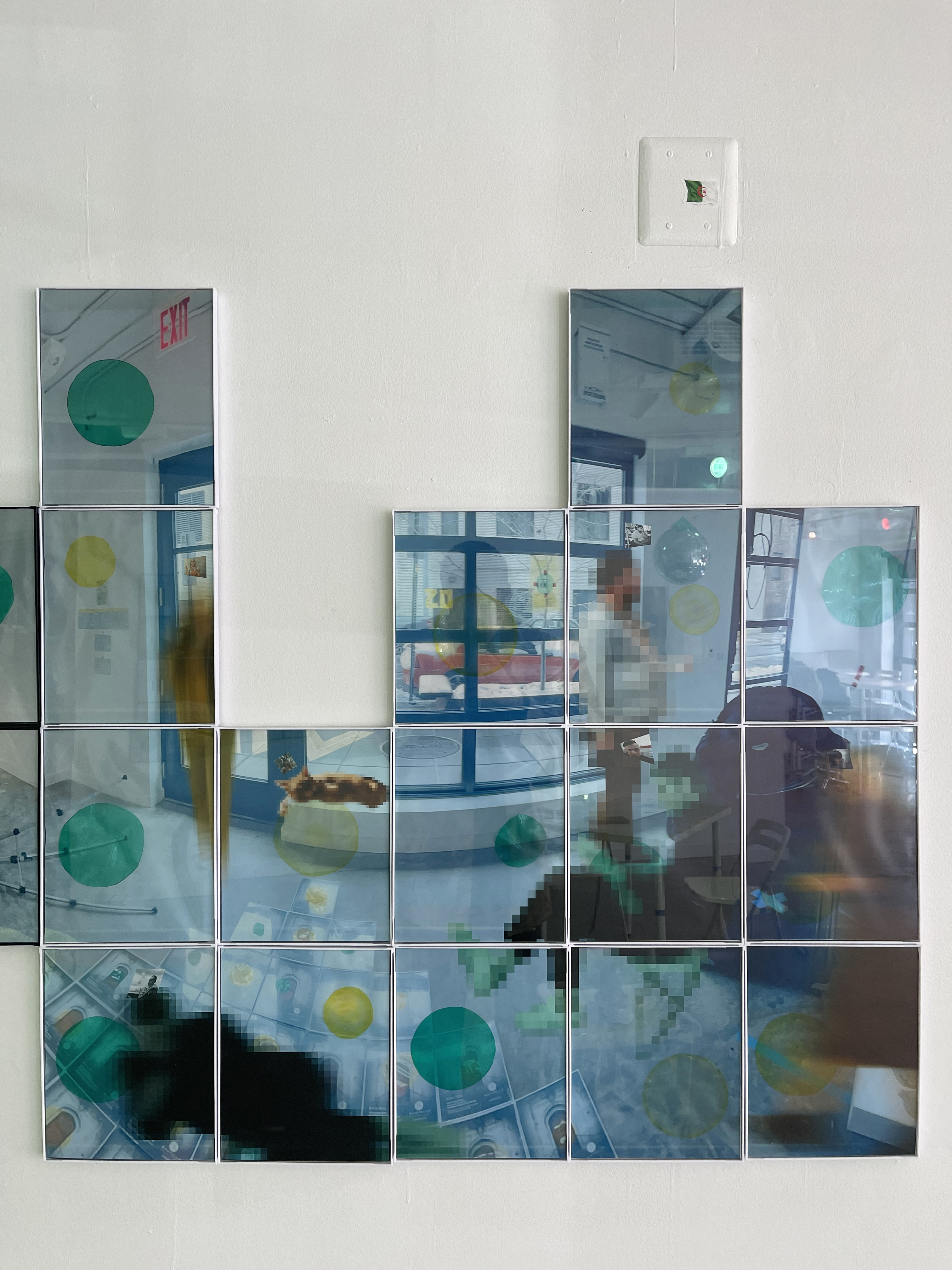


*domesticity weeks (second theme)*
![]()
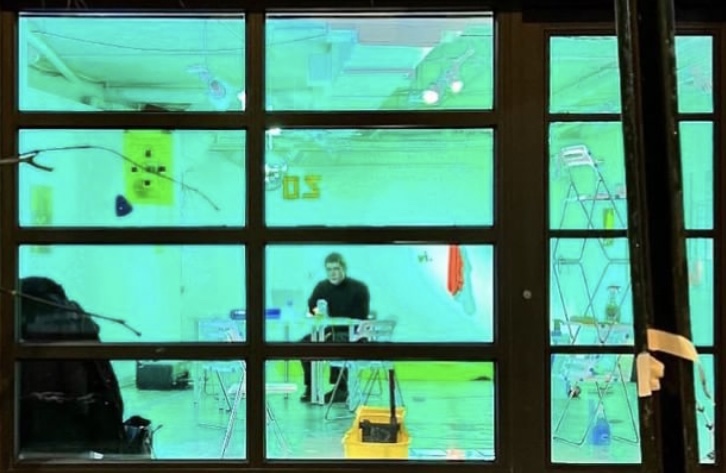
As soon as I was able to arrange the residency environment for living, I decided to stay over a couple of weekends and sleep in the space.

As the residency is located on the first floor of the buildin and has a large window, I thought to turn it in some form of sleeping performance, hence for the first weekend, I decided not to turn off the lights or use any window blinds. It was somewhat a challenging experience (at least from a sleeping perspective), as people were quite excited seeing a person sleeping and some interesting encounters happened these two nights. For instance, people were knocking in the window at night, cheering me up, but also (to my surprise) flashing. The latter made me think about the situation of double exposure, as I am exposing some intimate activity (like sleeping) to the outside, people seemed to be prone to demonstrate some form of intimacy (even in a perversive way), for example exposing themselves.
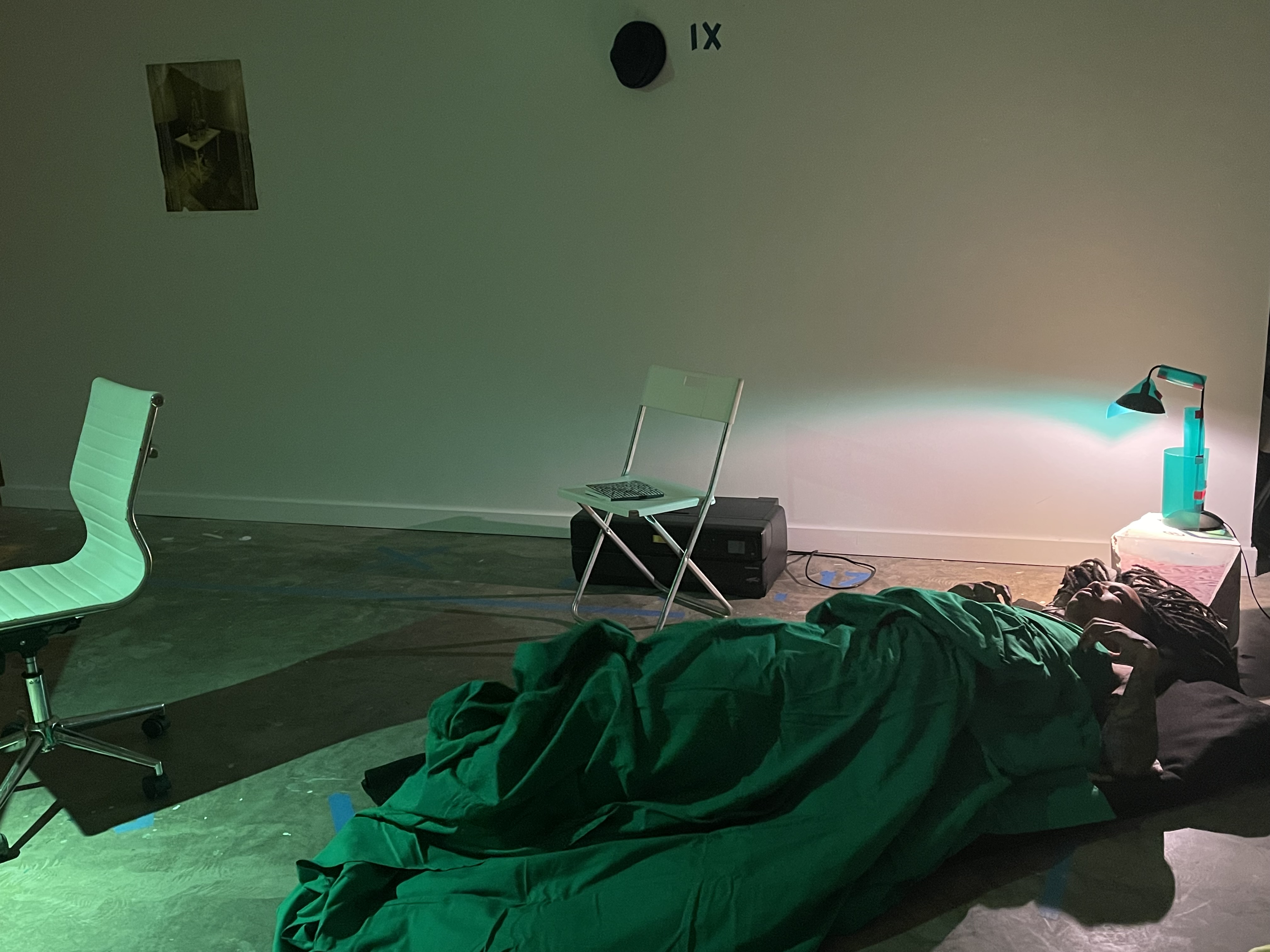
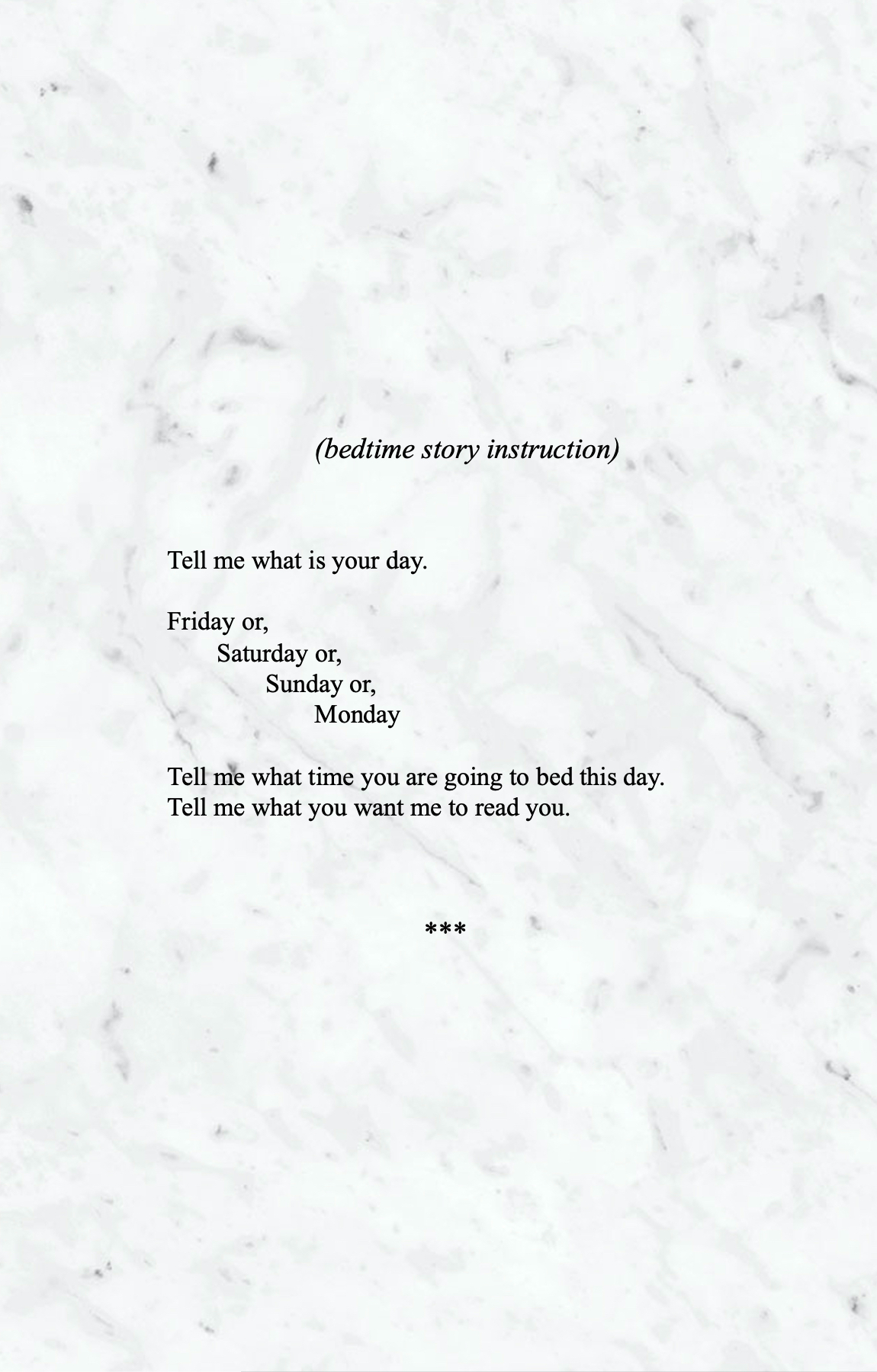
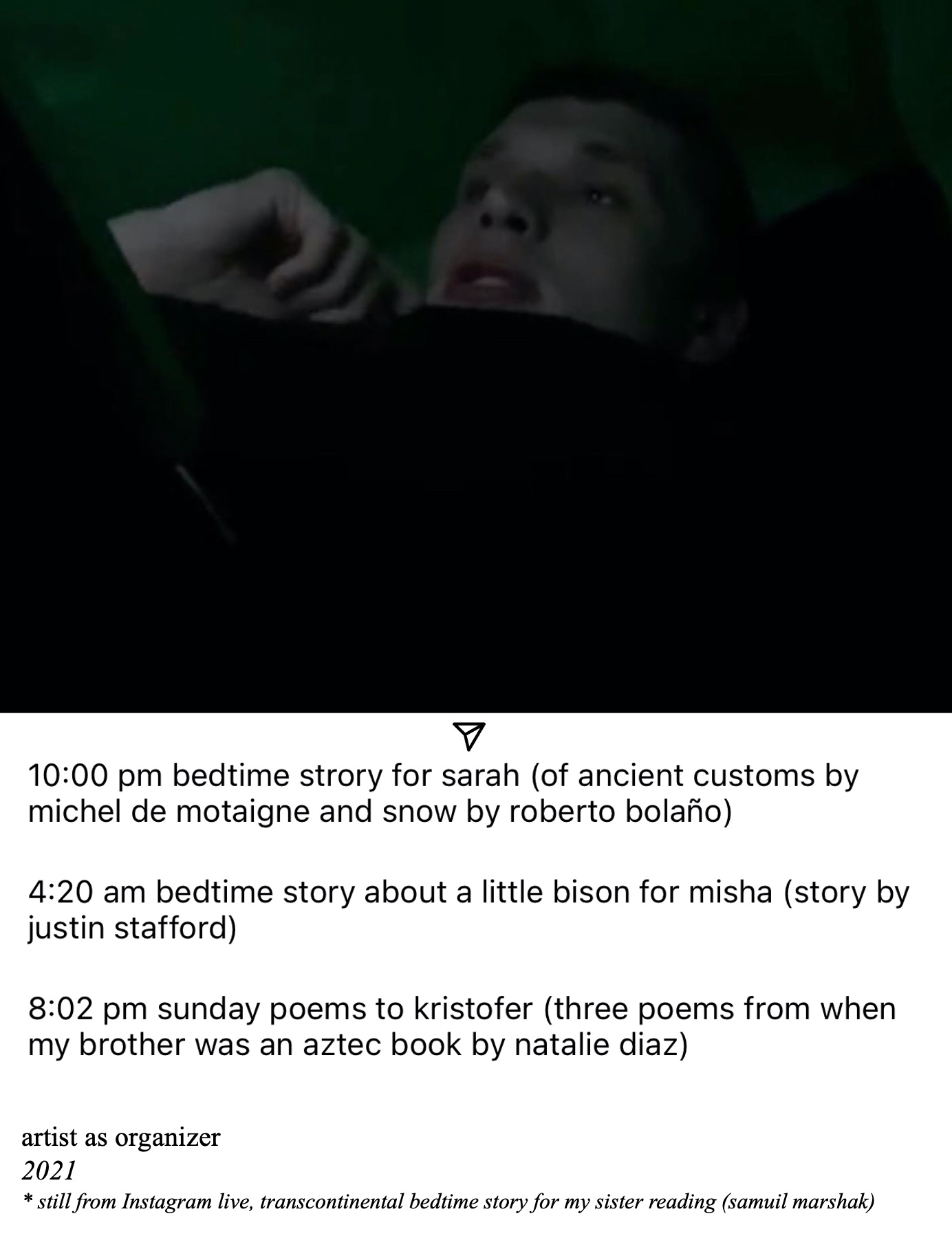
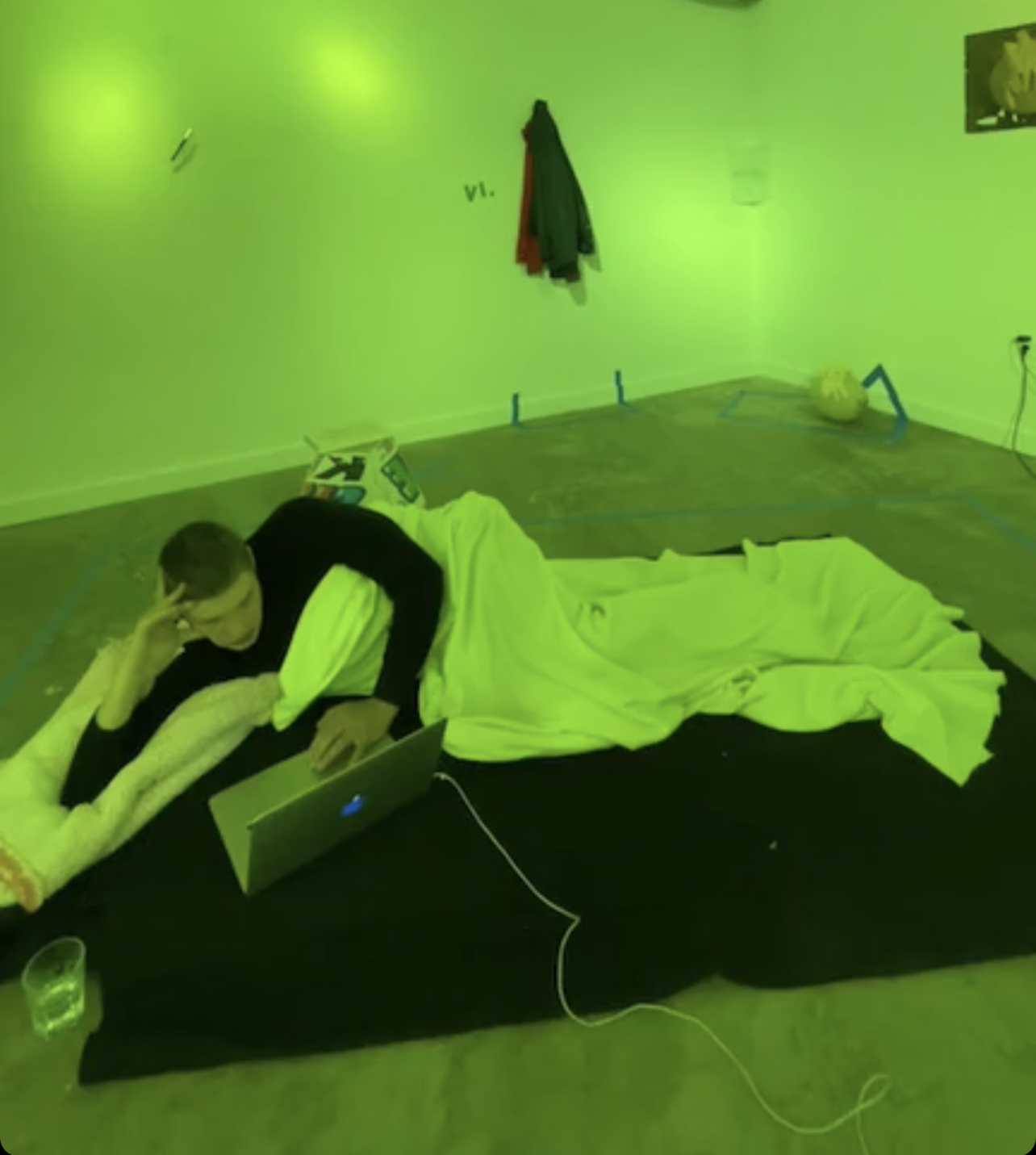

For the second domesticity weekend, my activity was a bedtime story performance. I posted an instruction and invited people to tell me what to read them before they would go to sleep. In return, I asked them to do the same for me. Soon I booked all my evenings (and even some parts of my night). People asked me to read poetry (thankfully to that I discovered authors like Louise Glück and Natalie Diaz). There was also some family experiences of reading to my sister (cute! it was also a day time in the US but already night in Russia), another person asked me to read Capital by Carl Marx (which I see now might have some tranquilizing effect), there was the situation of failure (someone asked me to read at 2 am and never showed up), finally, there was a sleepover with my friend artist, whom I was reading their morning pages and asked in return to inventing some bedtime story for me (it was a story about little bison). I also remember one person asked me an interesting question, that is what if someone would ask me to read something obscene and hateful (it would be particularly challenging because I was doing all the bedtime readings live – (un)luckily such a reading didn’t happen).
DETOURNEMENT II

At one point working on Class of Construction Identities of Yourself and The Others I decided to create a group chat to which I invited people who performed my identity instruction. As part of this project research into existing forms of collectivities, this chat (differently from zooms, Instagram lives, internet posts, and in-person meetings) was more open for regulation by the participants than just by me. Initially, I proposed to eight people who I invited in the chat to share instructions with me and other participants as well as to share the results of the performed instructions. I also proposed a voting procedure, for a new person added to the chat, based on sharing with the existing group a set of identities of a new chat participant.

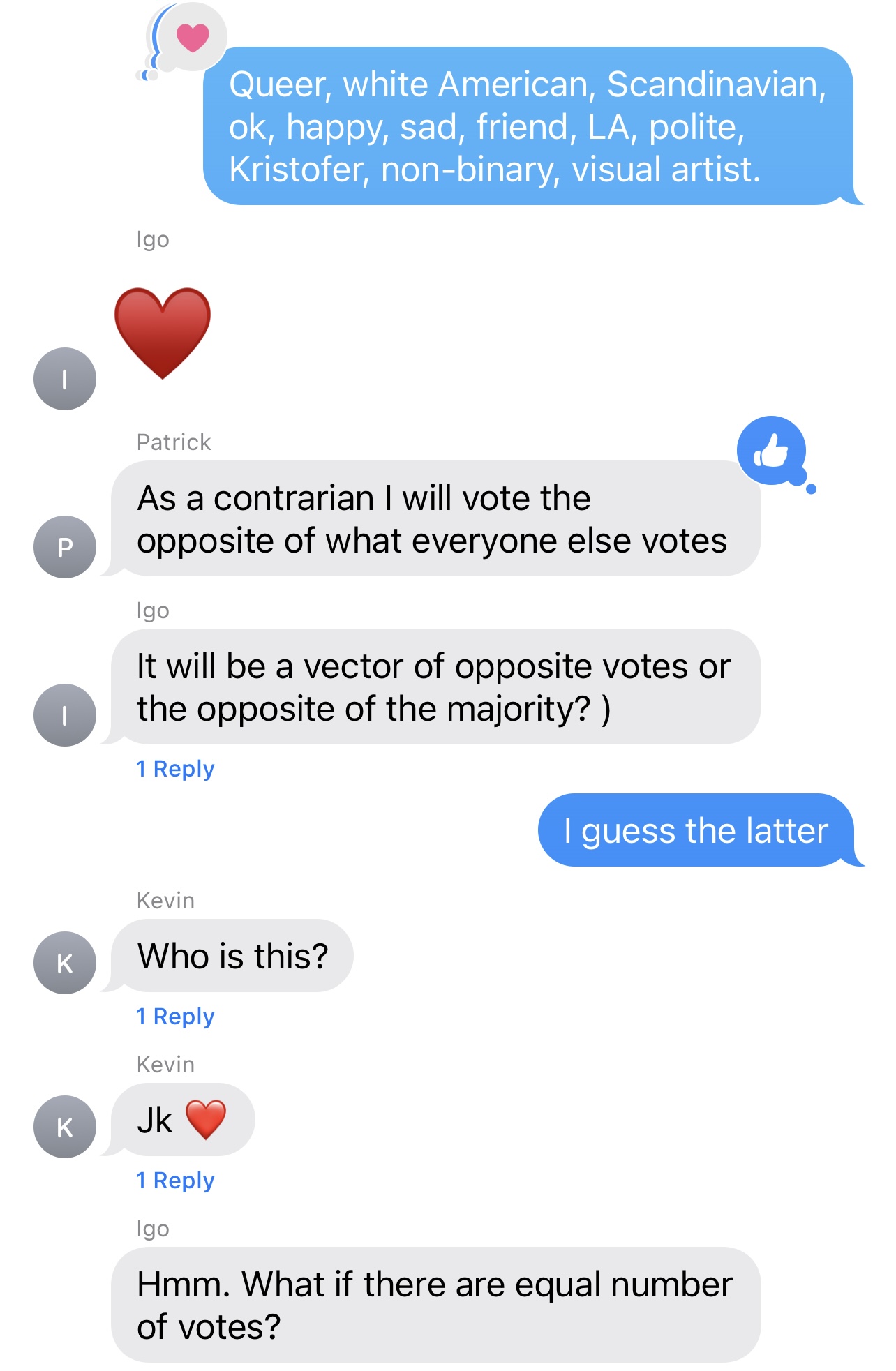
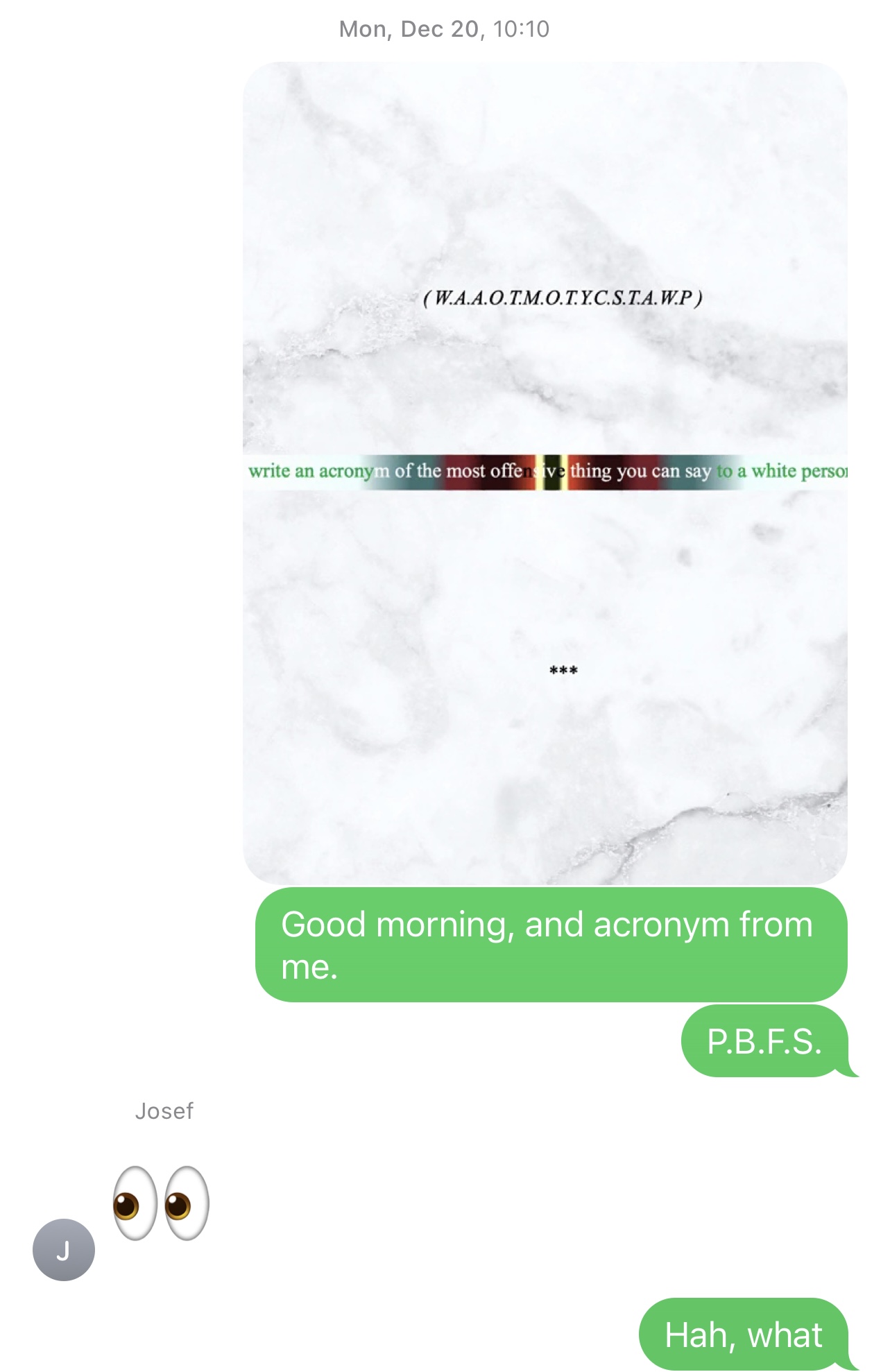
At one point the chat started to die out, as people who didn’t know each other were timid to engage that much with strangers. In response, I set up another chat group and told both groups that from now on they were going to compete. This idea of competition rejuvenated the dynamics inside the chats. My particular interest in these chat activities was to observe types of virtual organizations (also referred to as web 3.0), which are forms of self-regulated virtual collectivities that exist on the principles of decentralized authorities and economy.


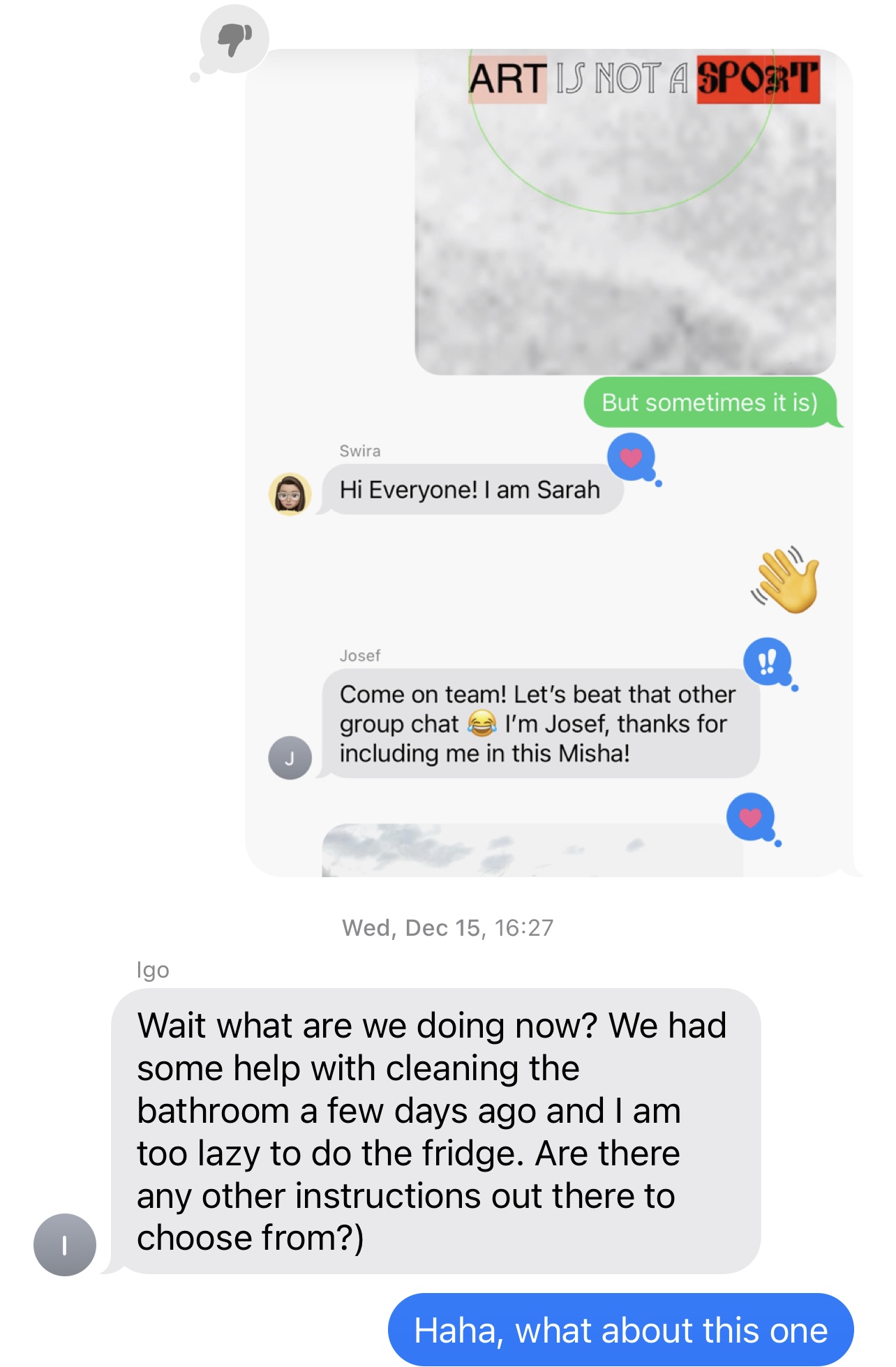
As the competition between the chat was over, I asked participants' consent to use the content of the chat for my work. I use this content to create a collection of digital works, that I am turning in NFTs. This collection eventually going to be equally distributed (like shares) between the participants of the chat.

!INSTITUTIONAL WEEK (THEME III)
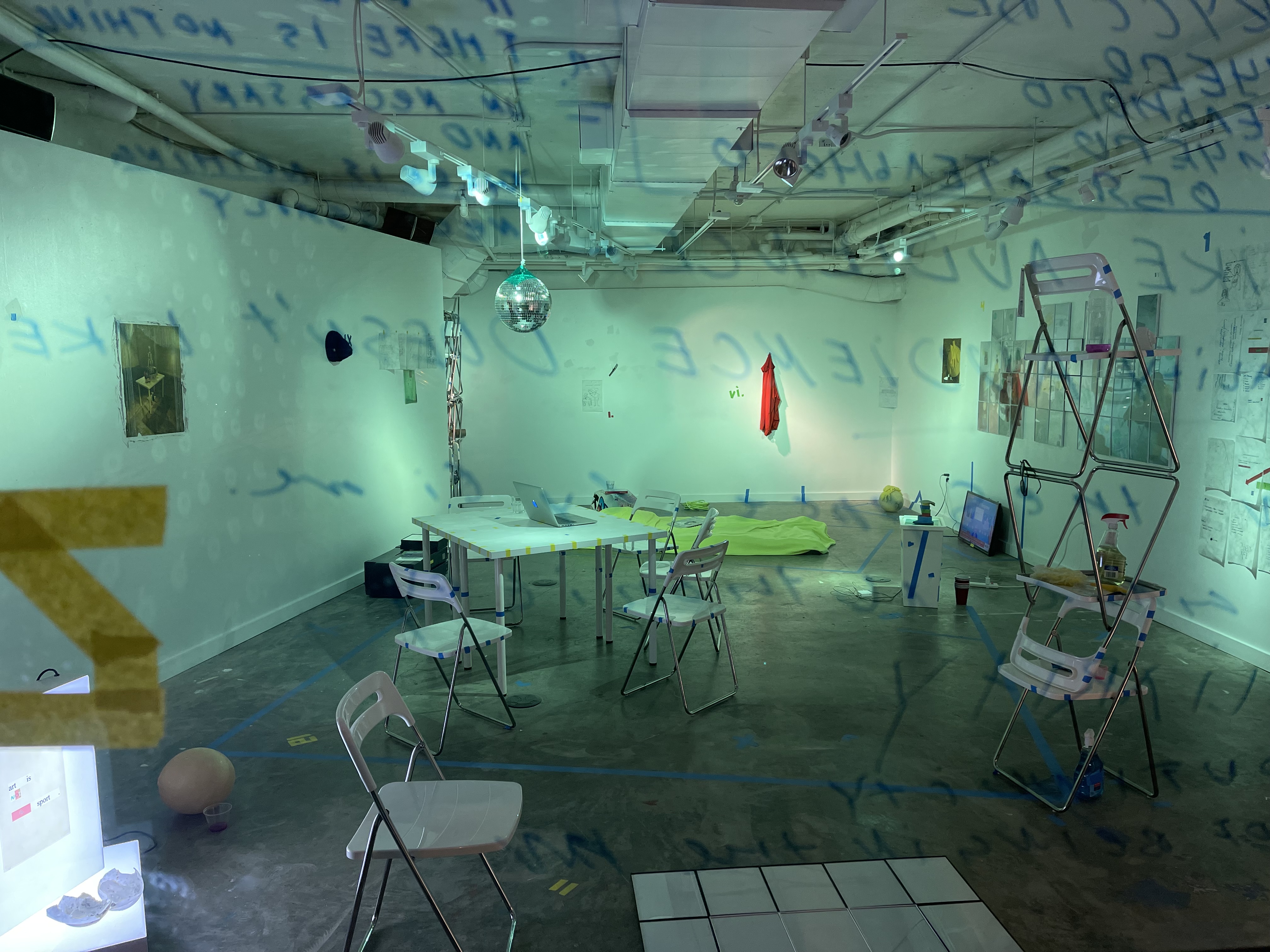

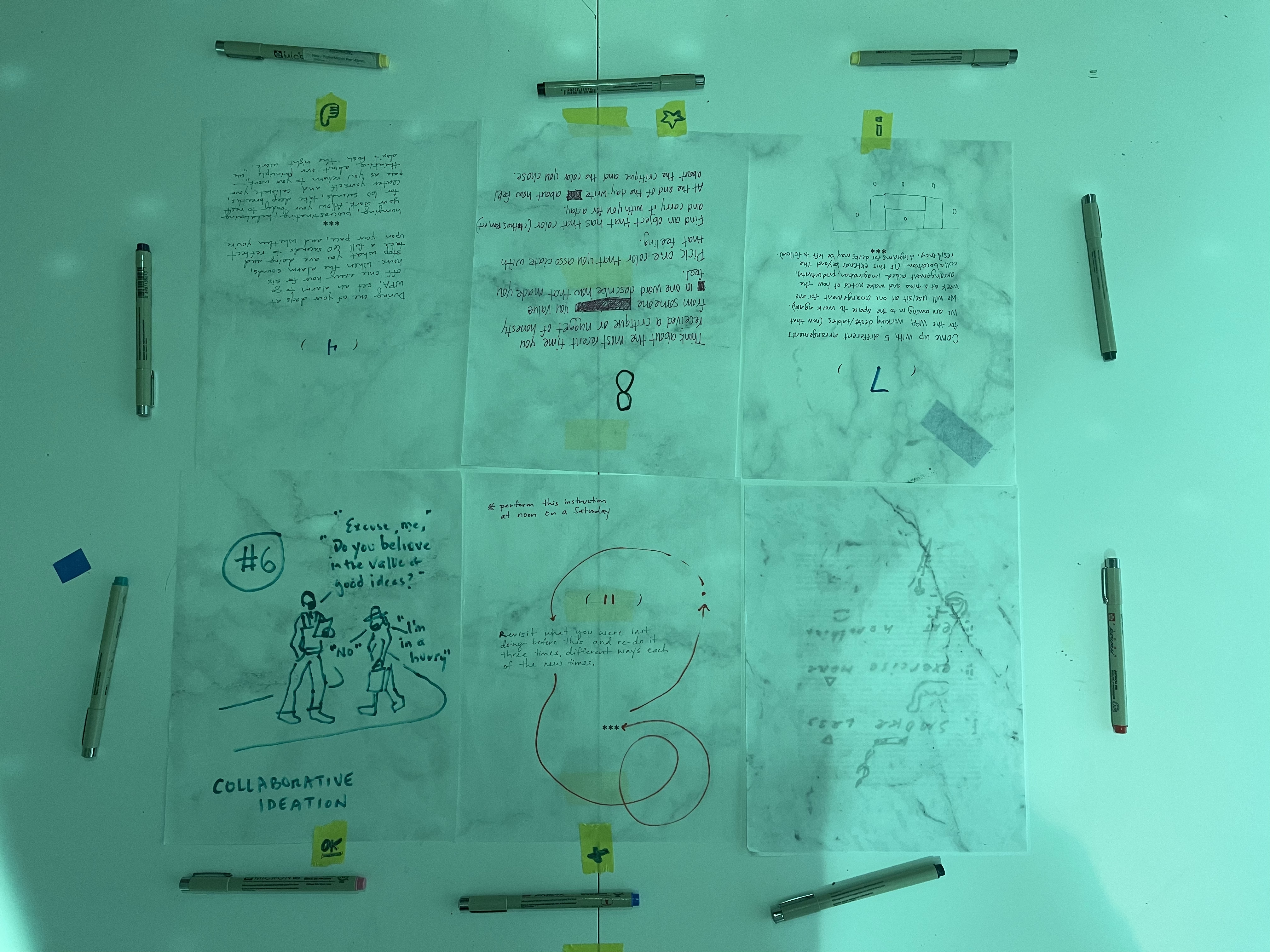
For the last part of the project, I was working with the WPA team, to comment on the forms of collectivity which emerge from collaboration between artist and institution. The work was organized around the WPA document, which was called the code of care. This was a living document initially created for the Board of WPA to render practices and values, that WPA employed to interact with artists like me. Apart from the ‘care’ in the name that circles back to the first part of this work, I was interested in seeing how this mere theoretical document can be turned into practice. For that, I asked the WPA team to choose one of the items of the code of care (1 out of 13) they like and write instructions based on it. Eventually these instructions I was performing over the last week of my residency.
![]()
![]()
![]()
All the instructions were quite different from each other. For instance, one was to set an alarm clock, that would go off every hour for six hours. Every time the alarm goes off, I should stop for a minute and reflect on what was happening to me at this moment. One episode during this day led me to reflect on the idea of failure. It happened when I went to grab a sandwich at Mcdonald's. I saw a couple playing chess there. I got interested in the game (it is still kind of a national sport in my country) and looked for a minute at the people playing. They saw me and invited me to join the game. At first, I refused, but when I went out I heard the alarm go off and I thought why did I refuse to play chess in McDonald's (thus decided to accept a proposal). The person proposed to play for a sandwich. eventually agreed to play blitz (5 games, for 5 min, and 1 dollar each). I lost the first game in 4 minutes. I remember the person said ‘you ain’t playing no good’, this day heard it 5 more times (each time we played). I asked how long he has been playing chess. the answer was ‘since Bobby Fischer won his first world championship’. We were done in 20 minutes. Contemplating this experience, I wrote a small note about failure by thinking about it from three different perspectives. First, about failure as an ultimate anticapitalistic act. Secondly, to think of failure in relation to the idea of archive, which somewhat is always based on the stories of success (the question is who defines what successful stories are – given that most of the archives are western-centric-, the question is what doesn't enter such an archive especially when it doesn't fit a certain view on what success is, ethically, aesthetically, or intellectually). Another reflection is on my relationship to failure as a form of emotional experience (derived from my ultimate focus on the result rather than on process), which by the framework of research (and temporal quality that this residency has) I was able to avoid and turn the experience of failure in the form of knowledge. I also posted two instructions in my group chats: what failure/success smells like. I discovered that apparently, failure smells like an astringent (slightly acidic and bitter), while that of mine that day smelled of French fries.
![]()
![]()
![]()
![]()
Another instruction confronted me to deal with the feeling of rejection (which is also a common feeling for artists in relation to institutions). I had to step outside and ask people who were passing by if they believed in the values of good ideas. In case they were, I should share with them my idea that I sought to improve. As the request in the instruction was to use an example of the real-world idea that I was looking to make better I decided to read people my artistic statement and ask to contribute to its improvement. I remember when during the first day of the performance I was following this instruction to the letter, didn’t lead to any success. So the next day tweaked that instruction and made my opening speech more personal (instead of jumping on the people right away and asking them to believe in the values of good ideas), which helped me collect all the necessary (10) improvements of my statement.
also this one

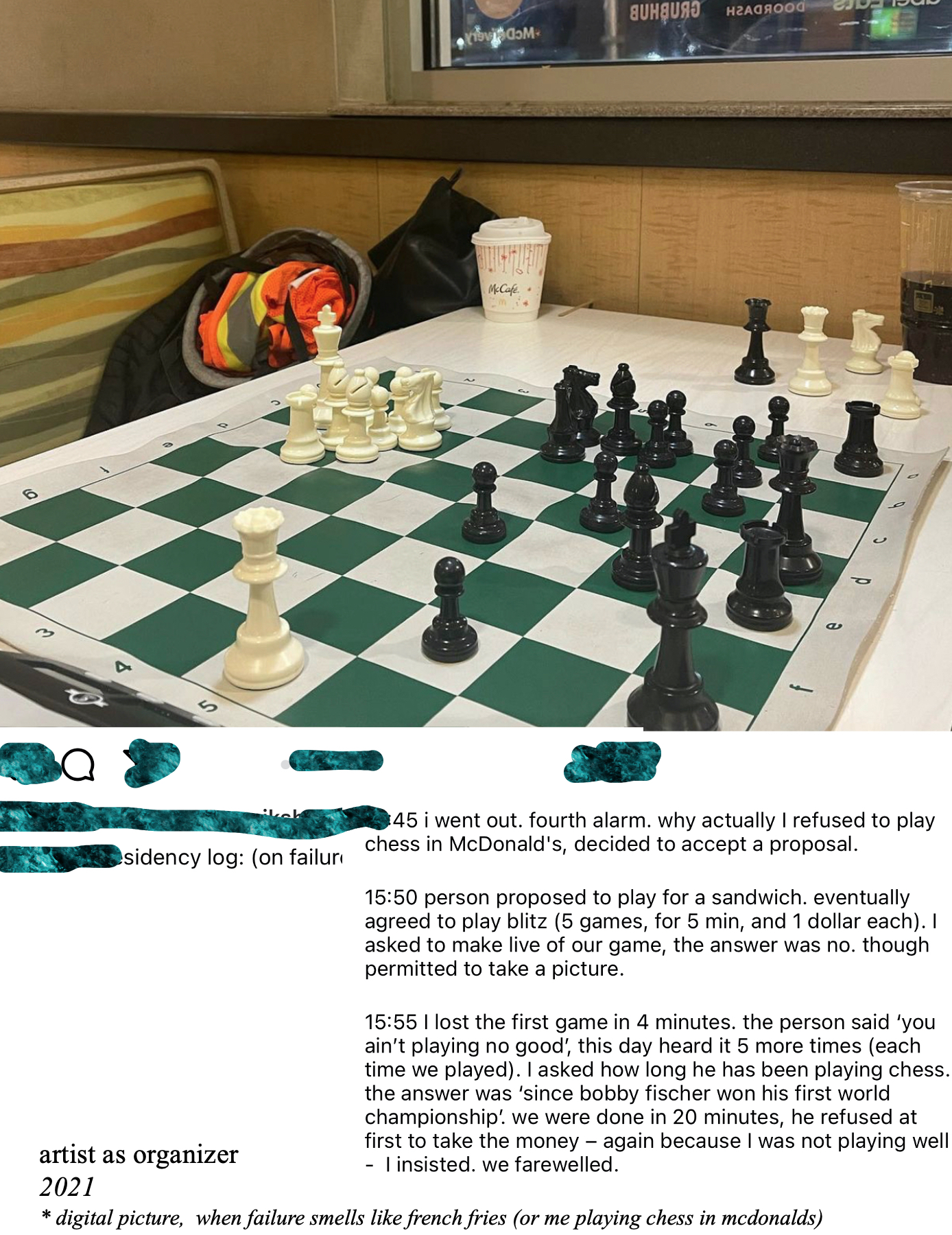

All the instructions were quite different from each other. For instance, one was to set an alarm clock, that would go off every hour for six hours. Every time the alarm goes off, I should stop for a minute and reflect on what was happening to me at this moment. One episode during this day led me to reflect on the idea of failure. It happened when I went to grab a sandwich at Mcdonald's. I saw a couple playing chess there. I got interested in the game (it is still kind of a national sport in my country) and looked for a minute at the people playing. They saw me and invited me to join the game. At first, I refused, but when I went out I heard the alarm go off and I thought why did I refuse to play chess in McDonald's (thus decided to accept a proposal). The person proposed to play for a sandwich. eventually agreed to play blitz (5 games, for 5 min, and 1 dollar each). I lost the first game in 4 minutes. I remember the person said ‘you ain’t playing no good’, this day heard it 5 more times (each time we played). I asked how long he has been playing chess. the answer was ‘since Bobby Fischer won his first world championship’. We were done in 20 minutes. Contemplating this experience, I wrote a small note about failure by thinking about it from three different perspectives. First, about failure as an ultimate anticapitalistic act. Secondly, to think of failure in relation to the idea of archive, which somewhat is always based on the stories of success (the question is who defines what successful stories are – given that most of the archives are western-centric-, the question is what doesn't enter such an archive especially when it doesn't fit a certain view on what success is, ethically, aesthetically, or intellectually). Another reflection is on my relationship to failure as a form of emotional experience (derived from my ultimate focus on the result rather than on process), which by the framework of research (and temporal quality that this residency has) I was able to avoid and turn the experience of failure in the form of knowledge. I also posted two instructions in my group chats: what failure/success smells like. I discovered that apparently, failure smells like an astringent (slightly acidic and bitter), while that of mine that day smelled of French fries.
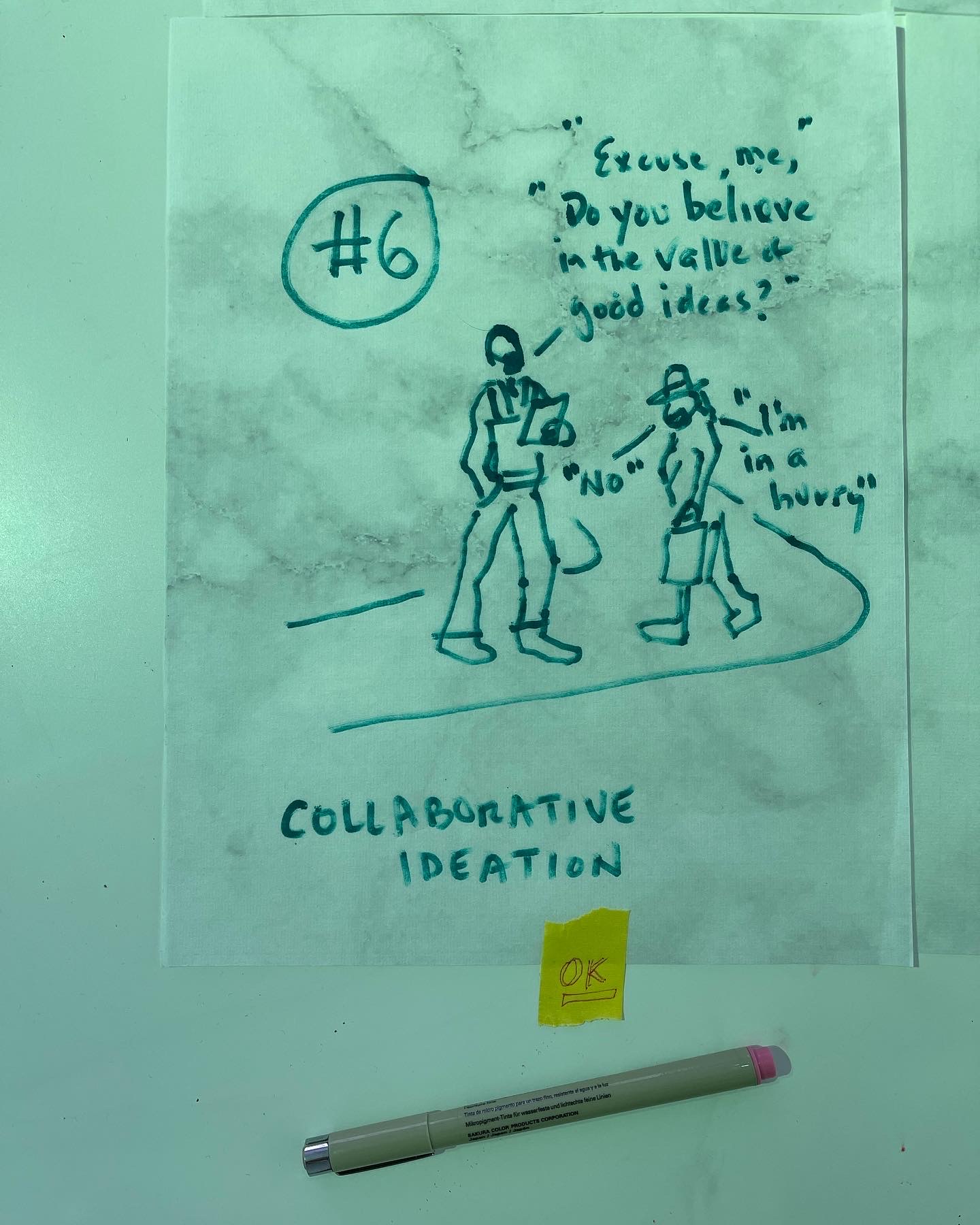

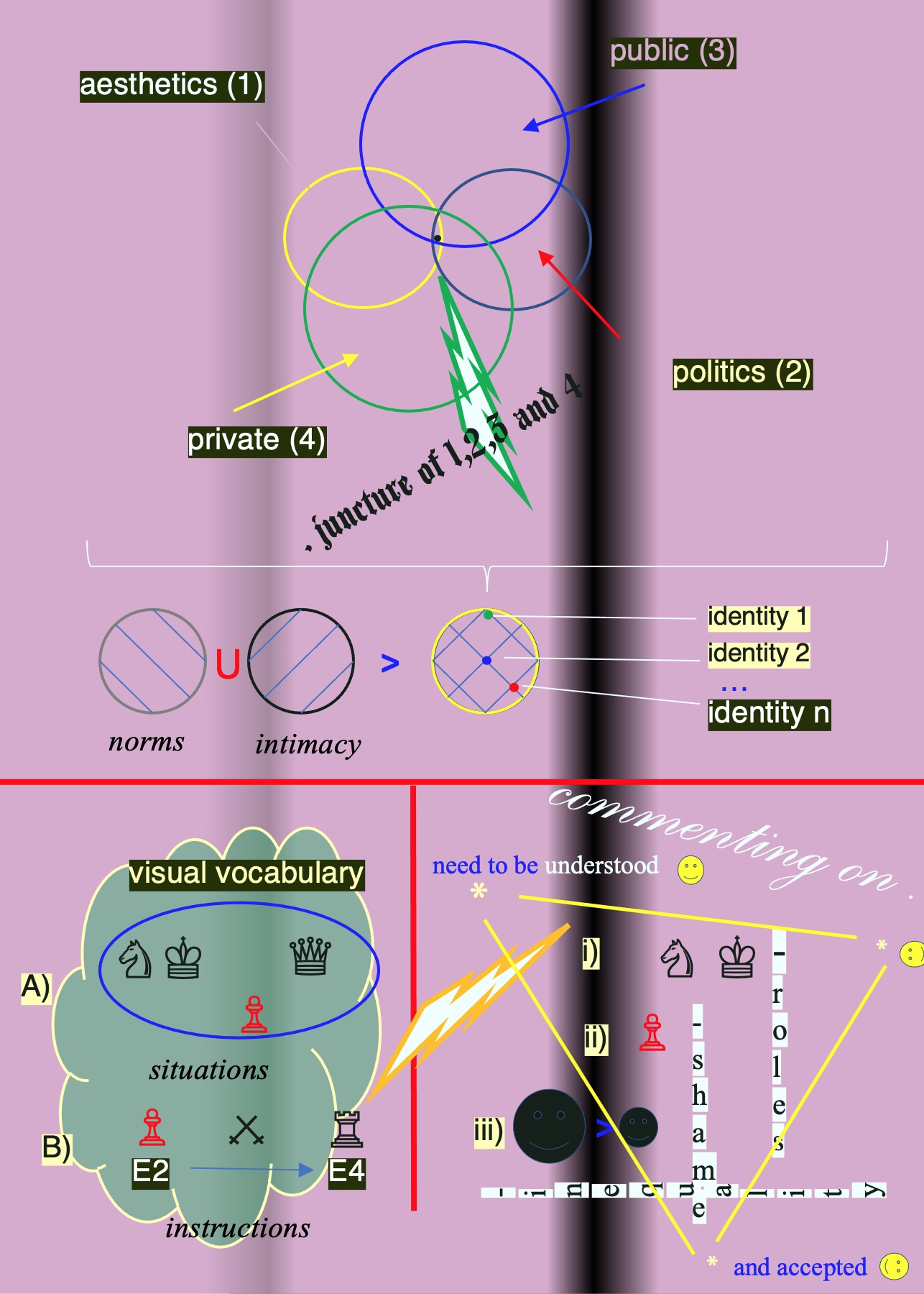

Another instruction confronted me to deal with the feeling of rejection (which is also a common feeling for artists in relation to institutions). I had to step outside and ask people who were passing by if they believed in the values of good ideas. In case they were, I should share with them my idea that I sought to improve. As the request in the instruction was to use an example of the real-world idea that I was looking to make better I decided to read people my artistic statement and ask to contribute to its improvement. I remember when during the first day of the performance I was following this instruction to the letter, didn’t lead to any success. So the next day tweaked that instruction and made my opening speech more personal (instead of jumping on the people right away and asking them to believe in the values of good ideas), which helped me collect all the necessary (10) improvements of my statement.
also this one
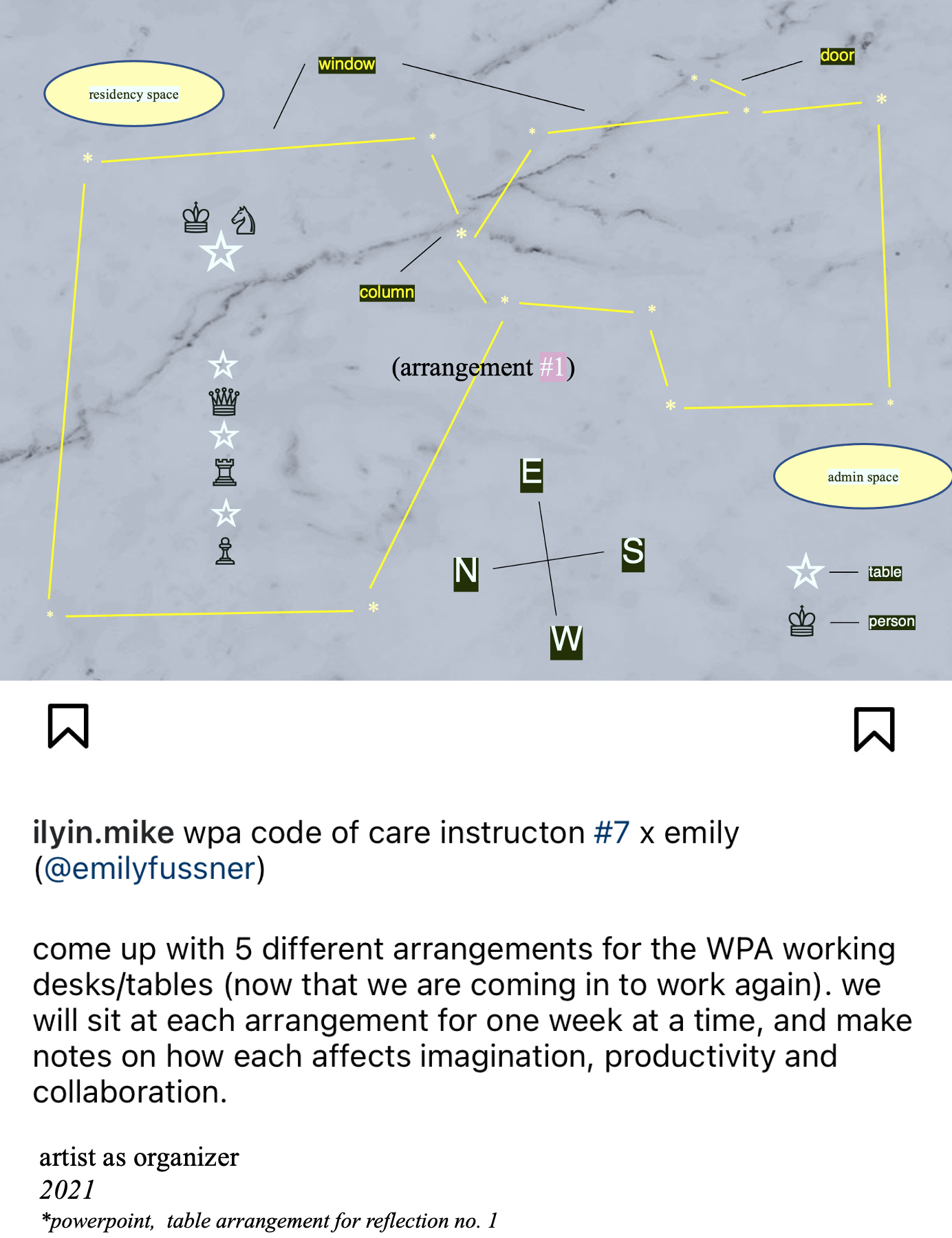

and this one


 detournement IIi
detournement IIi  Eventually, I used documentation of these
instructions performed during the institutional week to create another diagram
drawing around the WPA code of care.
Eventually, I used documentation of these
instructions performed during the institutional week to create another diagram
drawing around the WPA code of care.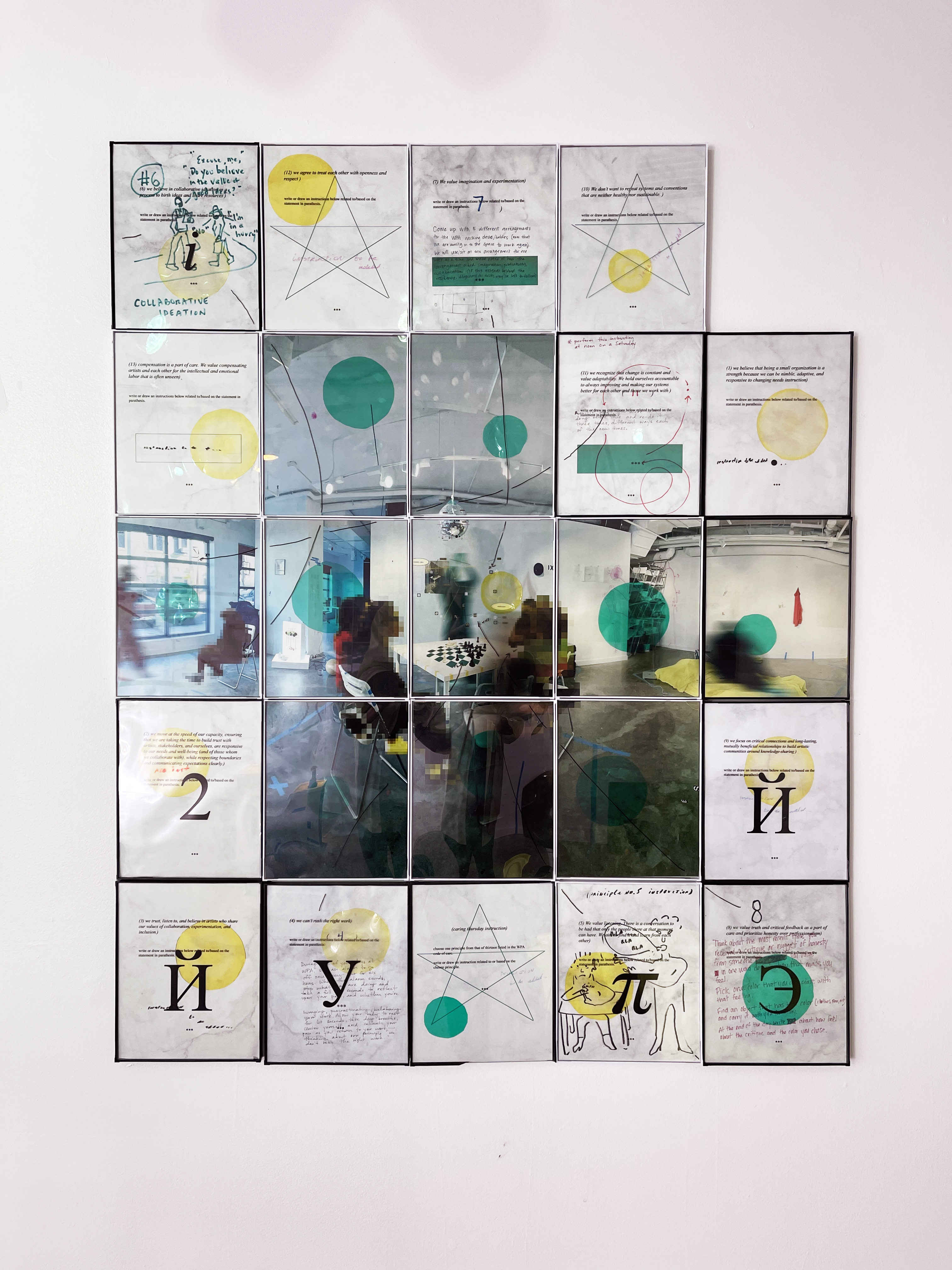



~last days

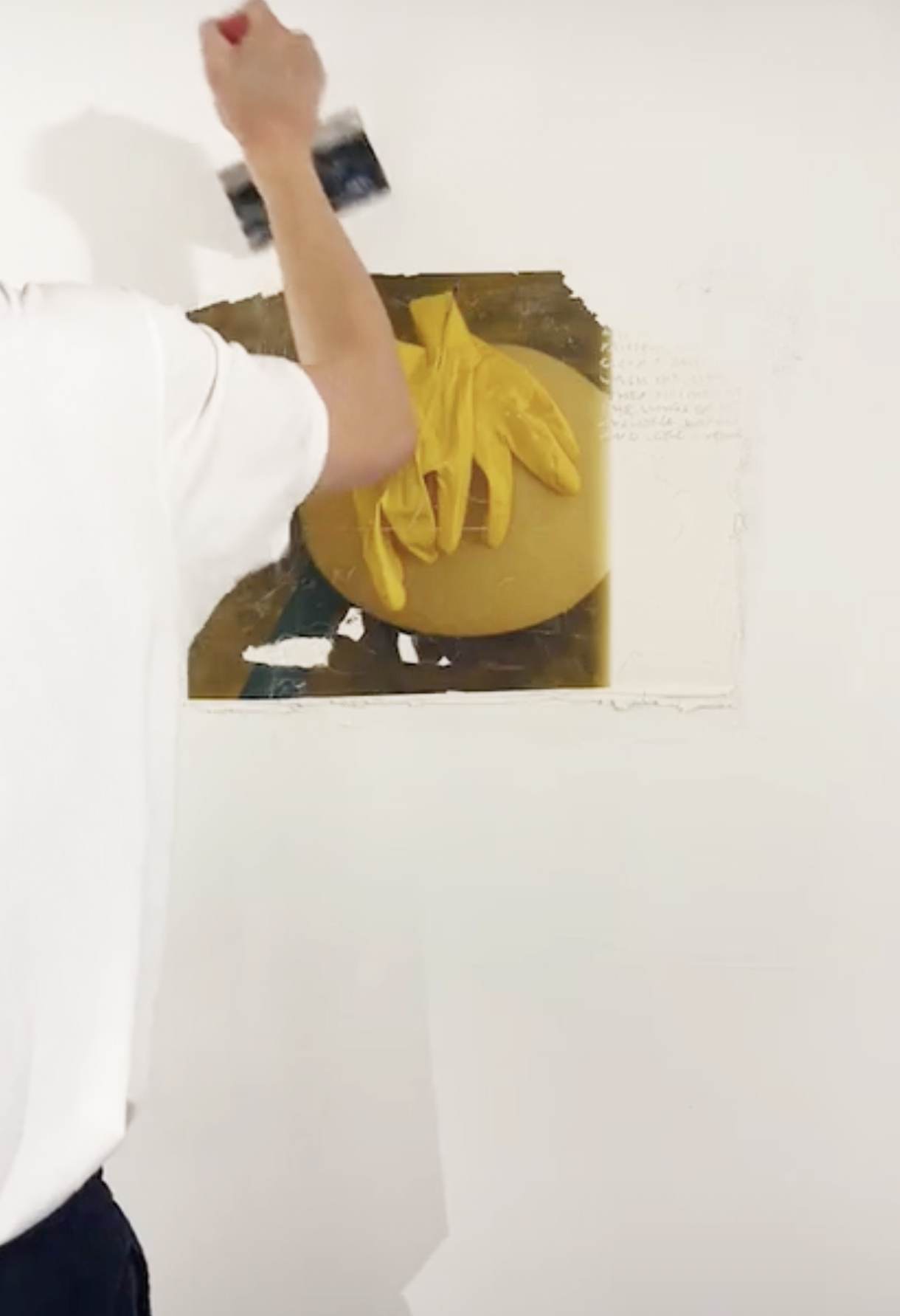
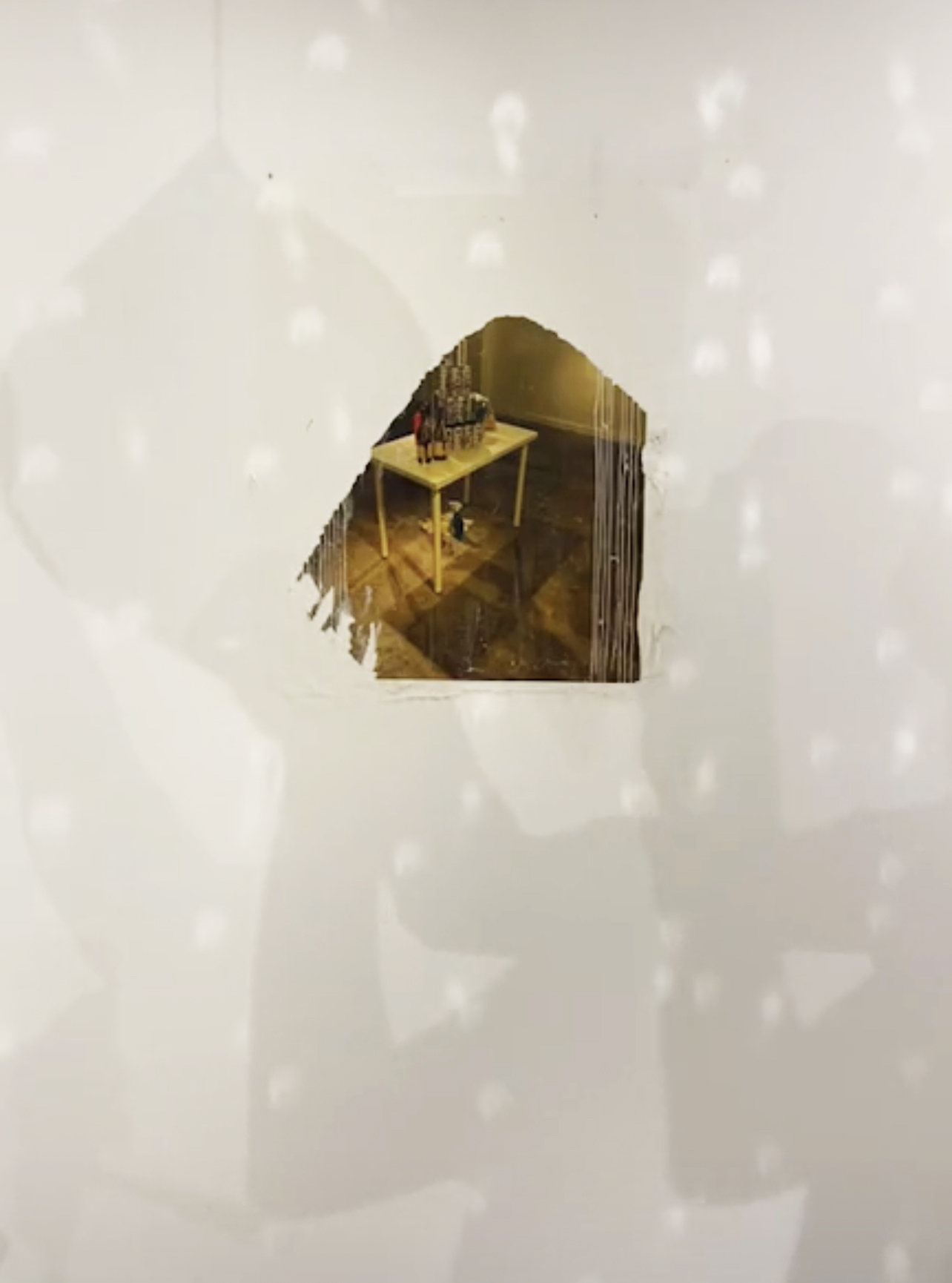
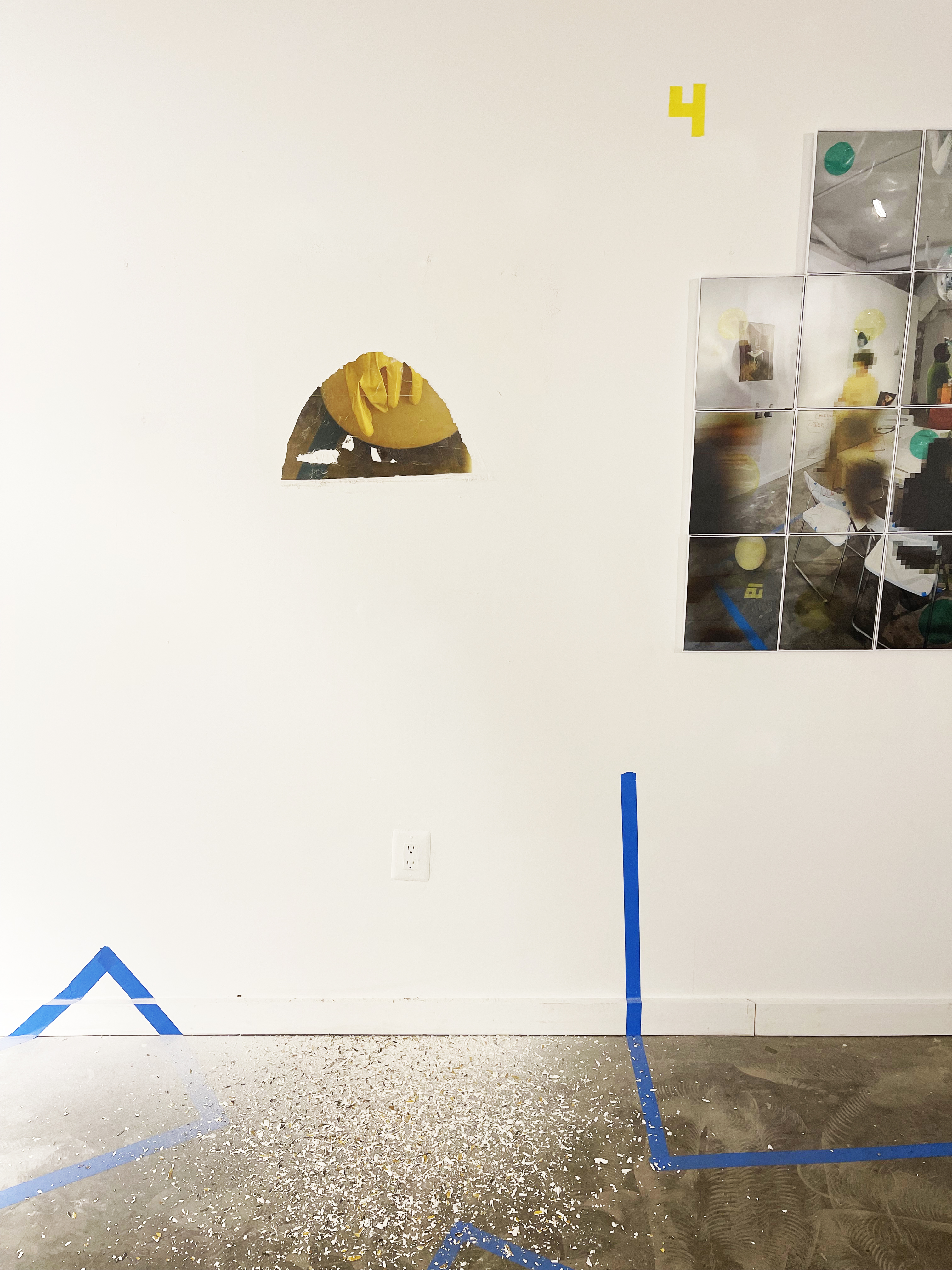

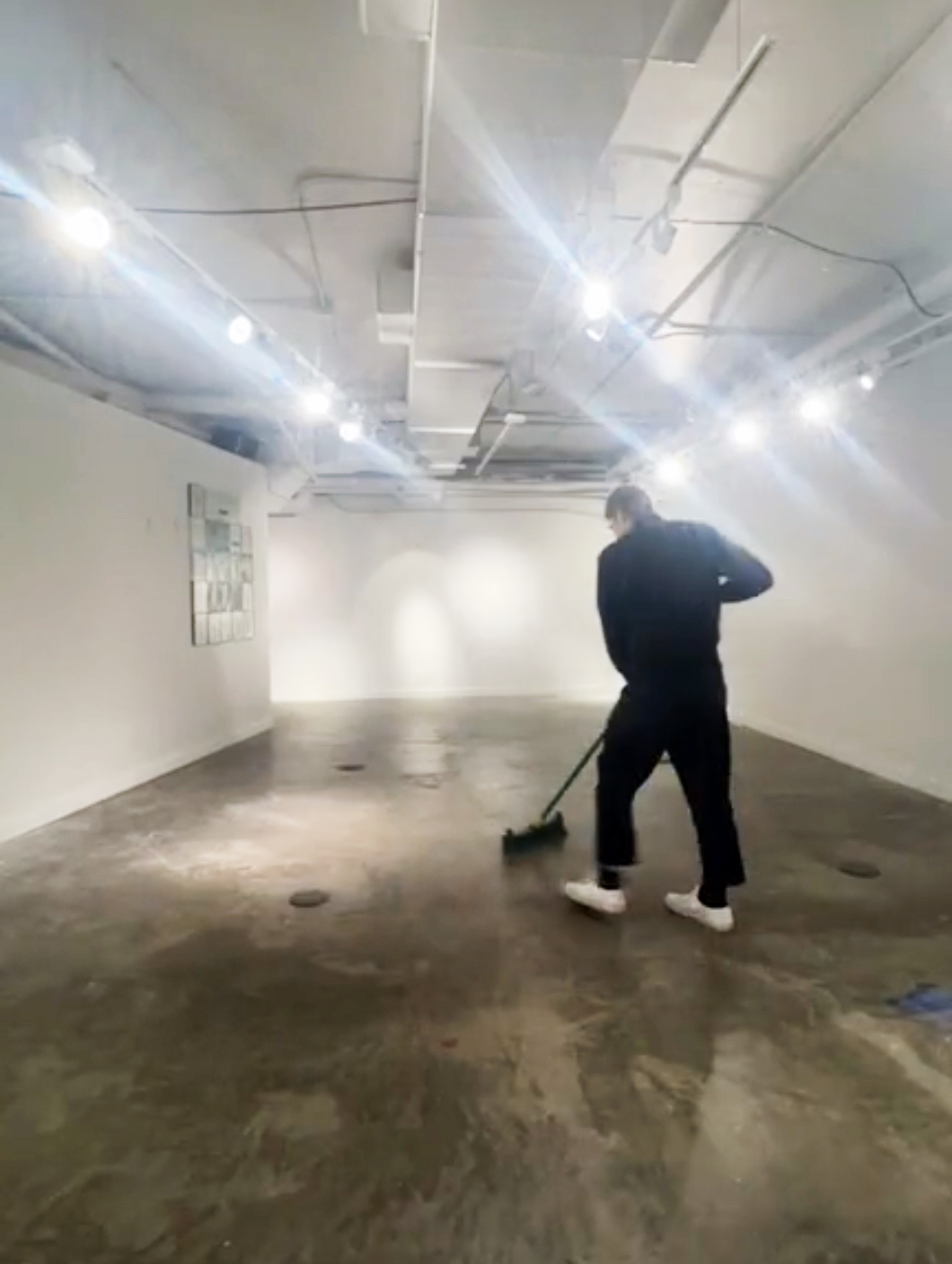

want to add this poem in the end, that is not by form rather the original idea relates to what was happening the last day. anyway will post it here:
He was my North, my South, my East and West, My working week and my Sunday rest, My noon, my midnight, my talk, my song; I thought that love would last for ever: I was wrong.
The stars are not wanted now: put out every one; Pack up the moon and dismantle the sun; Pour away the ocean and sweep up the wood. For nothing now can ever come to any good.